Winter birds in New Brunswick are a diverse range of species that have chosen to make the province their home during the colder months of the year.
These birds are well adapted to withstand harsh winter weather conditions and have developed unique survival strategies that allow them to thrive in this challenging environment.
From the smallest winter visitors to the large and majestic birds of prey, the province of New Brunswick is home to an impressive variety of winter birds that are a delight to watch and observe.
Whether you are a seasoned bird-watcher or just starting to explore the fascinating world of ornithology, these winter birds offer a unique opportunity to connect with nature and discover the beauty of New Brunswick’s wildlife.
1. American Goldfinch
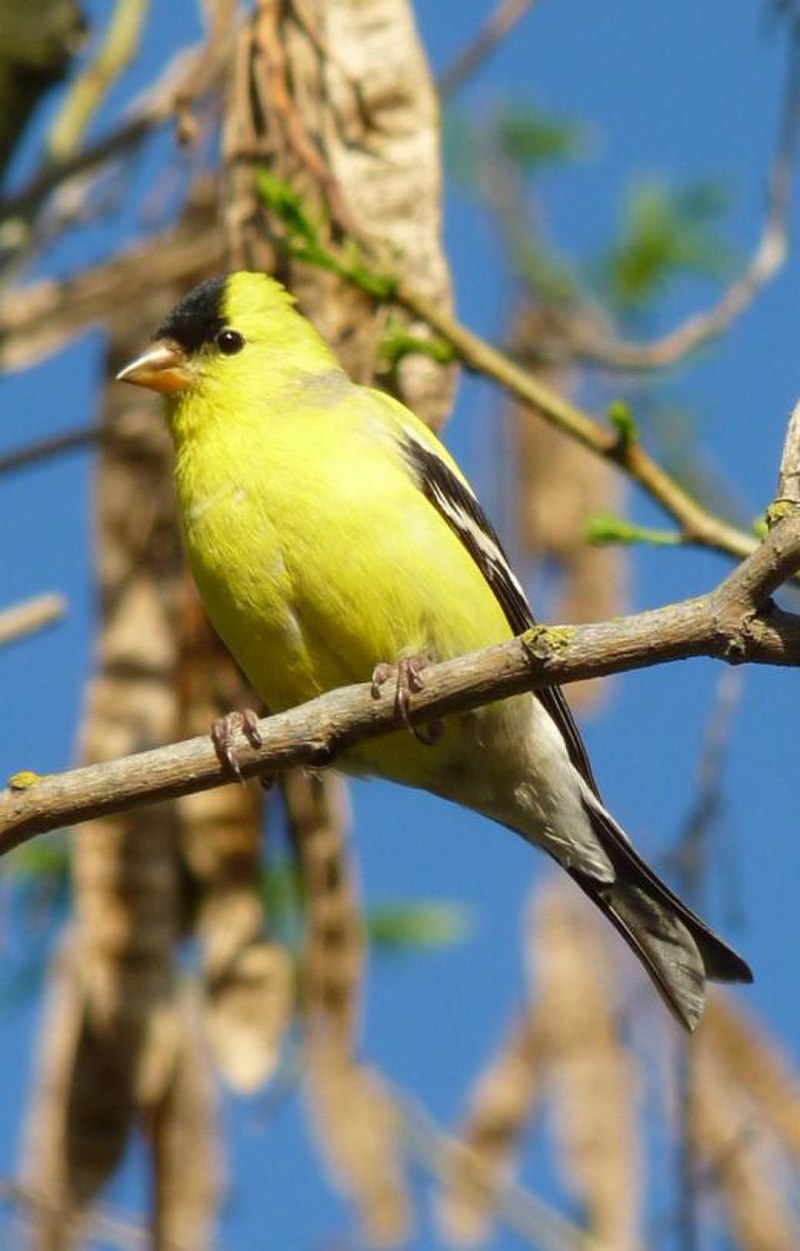
The American goldfinch is a small North American bird in the finch family. Males are vibrant yellow with black wings and tail, while females are duller in colouration.
It migrates from mid-Alberta to North Carolina during breeding season, south of Canada–United States border to Mexico for its wintering grounds.
The only finch which undergoes complete molt every year, it displays sexual dichromatism where males have brighter colours than their female counterparts.
They feed mainly on seeds but also eat insects such as aphids and caterpillars when raising youngs; they often occur near thistles or other plants that produce viable seed heads.
Their call consists of an array of chirps and trills making them quite conspicuous.Scientific classification:
| Kingdom | Animalia |
| Phylum | Chordata |
| Class | Aves |
| Order | Passeriformes |
| Family | Fringillidae |
| Subfamily | Carduelinae |
| Genus | Spinus |
| Species | S. tristis |
Also Featured In: Most Common United States Birds, Blue Birds You’ll Found around Us
2. Black-Capped Chickadee

The black-capped chickadee is a small and cheerful songbird found in deciduous and mixed forests across North America. It has an iconic black cap, white cheeks, gray back and wings with whitish bars on them.
The underparts are usually light colored or greyish brown. This species is well adapted to cold winters as it can reduce its body temperature by up to 8°C while roosting at night; this helps save energy during the colder months of the year.
It feeds mainly on insects but also eats seeds, fruits and suet from bird feeders when available.
Black-capped chickadees are popular birds among backyard visitors due to their sociable nature – they often establish lifelong partnerships with one another for breeding purposes.
Furthermore, they have been designated as state birds of Massachusetts and Maine in USA plus New Brunswick in Canada – a testament to how beloved these little avian friends truly are.Scientific classification:
| Kingdom | Animalia |
| Phylum | Chordata |
| Class | Aves |
| Order | Passeriformes |
| Family | Paridae |
| Genus | Poecile |
| Species | P. atricapillus |
Also Featured In: Common Birds in the Cities, British Columbian Birds
3. Downy Woodpecker
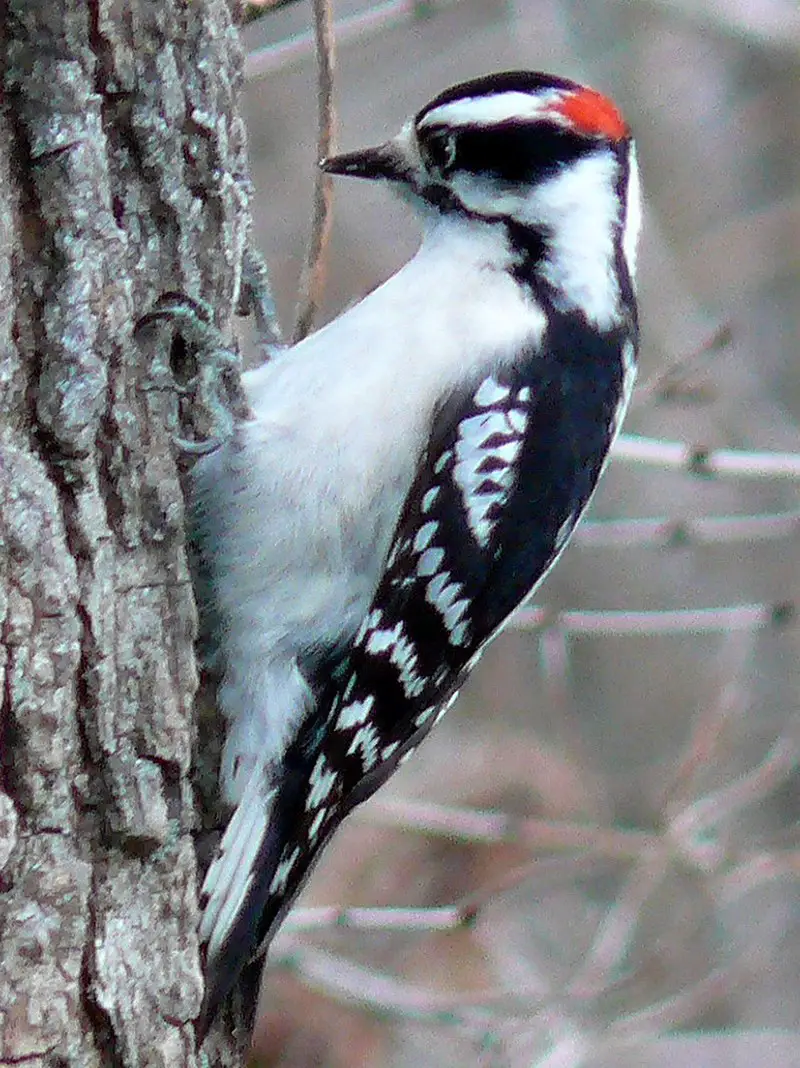
The downy woodpecker is a small species of woodpecker found in North America. Growing up to 7 inches long, it can be identified by its white belly and spotted wings.
It inhabits forests throughout the United States and Canada, with the exception of deserts in the southwest and northern tundra.
This bird nests in tree cavities and feeds mostly on insects but will supplement its diet with fruit or nuts when available.
The Downy Woodpecker has an unmistakable call that sounds like a loud ‘pik-er’, similar to other members of its family such as the Hairy Woodpecker.Scientific classification:
| Kingdom | Animalia |
| Phylum | Chordata |
| Class | Aves |
| Order | Piciformes |
| Family | Picidae |
| Genus | Dryobates |
| Species | D. pubescens |
Also Featured In: Birds in Calgary You’ll Love to See, Birds of Nova Scotia
4. American Crow

The American crow is a large bird of the Corvidae family, native to most parts of North America.
It is similar in size and structure to its European counterpart, the carrion crow, as well as Eurasia’s hooded crow.
The three species occupy the same ecological niche, but are distinguishable by their differences in appearance.
American crows have black feathers covering their entire body with wingspan averaging between 17-21 inches wide for males and 16-19 inches for females.
They feed on insects such as grasshoppers, beetles and caterpillars; they also eat grains from fields or abandoned farms during winter months when food sources become scarcer.
In addition to feeding habits American crows can be identified by their distinct call which resembles a “caw” sound that travels long distances over open terrain making them popular among birdwatchers.Scientific classification:
| Kingdom | Animalia |
| Phylum | Chordata |
| Class | Aves |
| Order | Passeriformes |
| Family | Corvidae |
| Genus | Corvus |
| Species | C. brachyrhynchos |
Also Featured In: Birds that Live in San Francisco Bay Area, Scavengers Birds You Should Know
5. Red-Bellied Woodpecker
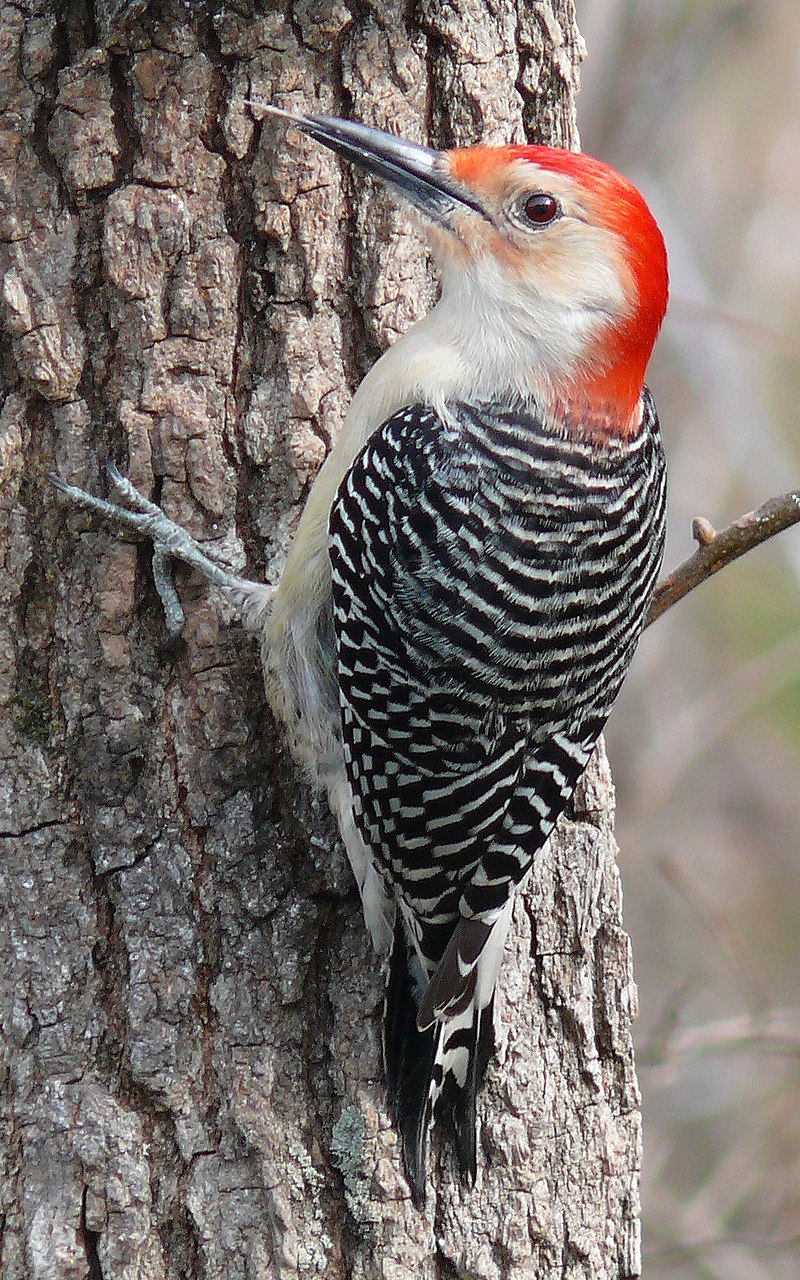
The Red-bellied woodpecker is a beautiful bird with an orange-red crown and nape. It breeds mainly in the eastern United States, ranging from Florida to Canada.
This medium-sized woodpecker of the family Picidae has black wings, white stripes on its back and tail feathers that are barred with black.
Its underside is mostly pale yellow or white but it also features some red coloration around its neck area.
Despite this subtle red hue, it should not be mistaken for the entirely red head and neck belonging to the Red-headed woodpecker of the same genus Melanerpes carolinus.
The Red bellied Woodpeckers diet consists primarily of insects such as ants, beetles and grasshoppers along with nuts fruits berries and tree sap which they will feed upon during different times throughout their life cycle.Scientific classification:
| Kingdom | Animalia |
| Phylum | Chordata |
| Class | Aves |
| Order | Piciformes |
| Family | Picidae |
| Genus | Melanerpes |
| Species | M. carolinus |
Also Featured In: Common Central Park Birds, Common Birds of Houston
6. House Finch

The House Finch is a species of finch native to western North America and has been introduced in the eastern half of the continent as well as Hawaii.
It’s an average-sized finch with adults measuring 12.5 – 15 cm (5 – 6 inches) long and having wingspans between 20 – 25 cm (8 – 10 inches).
The upperparts are brown, while its underparts range from pale grayish white to yellow depending on subspecies.
Its face is streaked or spotted with reddish coloration; males typically have brighter plumage than females due to sexual dimorphism.
They’re mostly found near human habitations such as farms and gardens where they feed on grains, fruits, insects etc., making them very popular among birders who want something colorful for their backyard.Scientific classification:
| Kingdom | Animalia |
| Phylum | Chordata |
| Class | Aves |
| Order | Passeriformes |
| Family | Fringillidae |
| Subfamily | Carduelinae |
| Genus | Haemorhous |
| Species | H. mexicanus |
Also Featured In: Common Birds That Live in Las Vegas, Birds That Live around Seattle
7. Dark-Eyed Junco

The Dark-eyed Junco is a species of small, grayish sparrows that are found across much of temperate North America and in the Arctic during summer.
It was formally described by Carl Linnaeus in 1766, who named it after its distinctive dark eyes.
This bird has a very variable appearance due to the many different subspecies it contains, making its systematics difficult to unravel.
The plumage varies from white or light gray on their underparts with slate grey backs and wings; black heads with white outer tail feathers; brown head stripes; yellow bills; pink legs and feet; as well as various shades between all these colours.
They also have considerable sexual dimorphism where males tend to be more colourful than females but share similar characteristics such as short tails and rounded bodies – both sexes being around 16 cm long when fully grown.Scientific classification:
| Kingdom | Animalia |
| Phylum | Chordata |
| Class | Aves |
| Order | Passeriformes |
| Family | Passerellidae |
| Genus | Junco |
| Species | J. hyemalis |
Also Featured In: Lake Tahoe Birds, Birds that Live in Vancouver
8. Mourning Dove
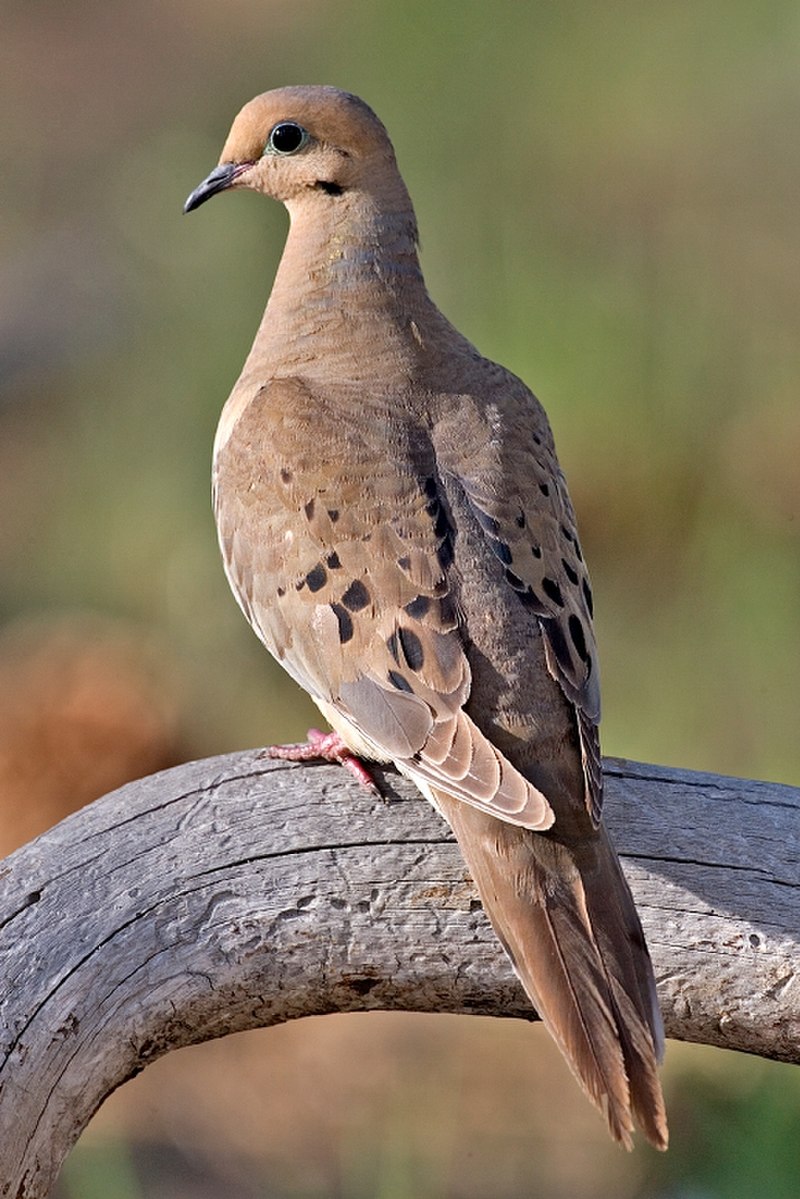
The Mourning Dove is a breathtakingly beautiful bird. It has stunning gray and brown feathers with white tipped wings, giving it an elegant appearance. Its long tail also adds to its graceful look in flight.
A symbol of peace and serenity, they are abundant across North America and can be found in gardens or open fields throughout the year.
As well as being popular game birds for hunters, they feed on grains such as wheat and millet providing important food sources for wildlife species including foxes, coyotes, skunks and raccoons.
These doves have a distinctive cooing sound that can often be heard echoing through woodlands during summer evenings making them one of nature’s greatest treasures.Scientific classification:
| Kingdom | Animalia |
| Phylum | Chordata |
| Class | Aves |
| Order | Columbiformes |
| Family | Columbidae |
| Genus | Zenaida |
| Species | Z. macroura |
Also Featured In: Most Common Nature Birds, Birds of Symbolism
9. Red-Winged Blackbird

The red-winged blackbird is a beautiful bird found in most of North America and Central America.
Its distinct features include a glossy black body, with white shoulder patches and bright red wing coverts year round.
It prefers wetland habitats such as marshes, ponds, lakeshores and agricultural fields. During breeding season they inhabit grassy areas near water then move south for the winter months.
For food they mainly eat insects but also consume wild fruit or grains.
They are very social birds often seen in large flocks during migration times when their unmistakable “conk-la-ree” call can be heard echoing across the sky.Scientific classification:
| Kingdom | Animalia |
| Phylum | Chordata |
| Class | Aves |
| Order | Passeriformes |
| Family | Icteridae |
| Genus | Agelaius |
| Species | A. phoeniceus |
Also Featured In: Flocks Birds around Us, Birds that Calls in the Morning
10. Eastern Towhee
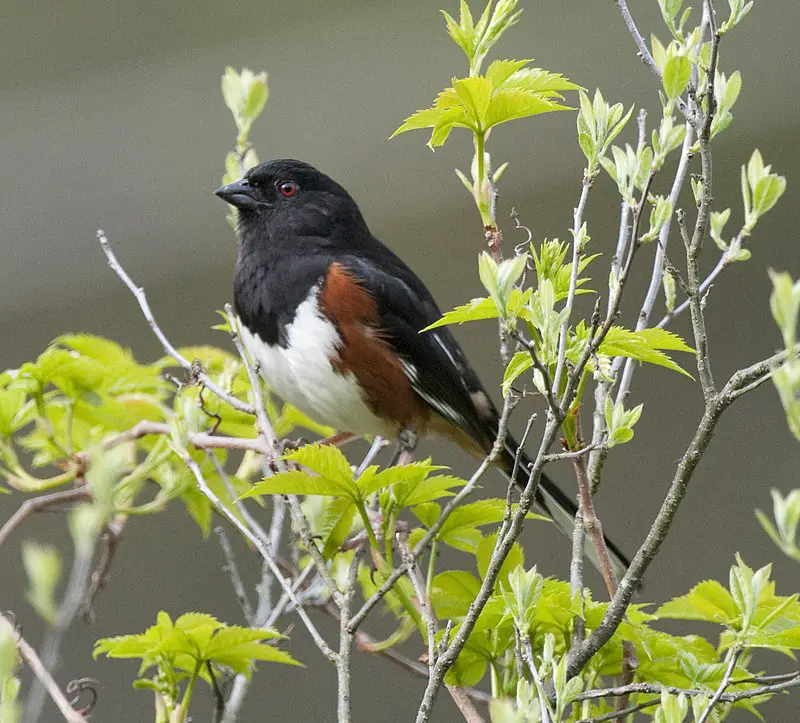
The Eastern Towhee is a large New World sparrow, native to brushy areas of eastern North America. These birds have distinct black and white markings, with chestnut brown underparts.
They nest either low in bushes or on the ground beneath shrubs. Northern towhees are known for migrating south during the winter months.
In recent decades, taxonomy debates have left some questioning whether this bird should remain its own species or be grouped together with the Spotted Towhee as one species — Rufous-sided Towhee.
This lively songbird has a bubbly personality and can often be seen hopping around on branches looking for food such as insects, fruits and seeds.Scientific classification:
| Kingdom | Animalia |
| Phylum | Chordata |
| Class | Aves |
| Order | Passeriformes |
| Family | Passerellidae |
| Genus | Pipilo |
| Species | P. erythrophthalmus |
Also Featured In: Black And White Birds You Don’t Know About, Brown Tennessee Birds
11. Chipping Sparrow
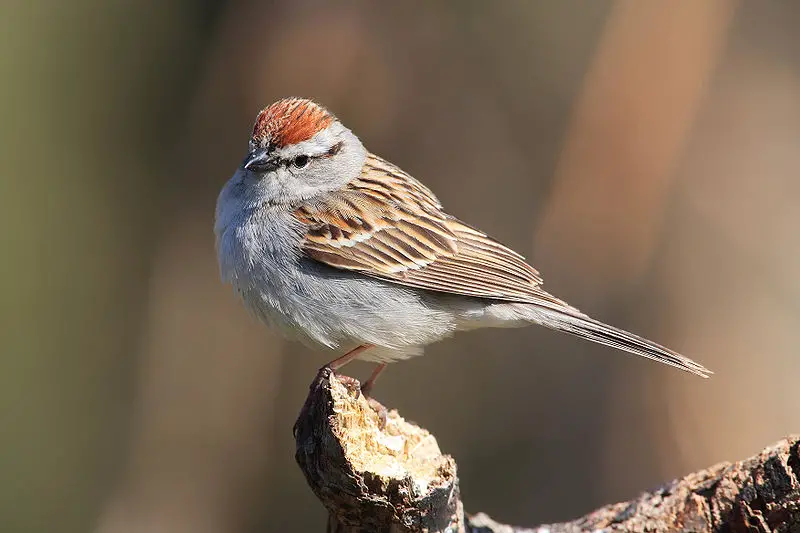
The Chipping Sparrow is a small passerine bird found across most of North America. It has two subspecies, the eastern and western chipping sparrows which migrate seasonally to overwinter in warmer climates.
The birds are grey above with white underparts, have a rufous cap with black stripes and large eyes surrounded by light brown feathers.
They feed mainly on seeds but can also be seen eating insects during breeding season when raising their young chicks.
These intrepid little birds live in open grasslands such as prairies or meadows where they build cup-shaped nests in trees or shrubs to raise their young family.
Their cheerful song often sounds like ‘chips’ hence its name; Chipping Sparrow.Scientific classification:
| Kingdom | Animalia |
| Phylum | Chordata |
| Class | Aves |
| Order | Passeriformes |
| Family | Passerellidae |
| Genus | Spizella |
| Species | S. passerina |
Also Featured In: Most Popular Bird Species in North America, Birds that Live in Manitoba
12. Yellow-Rumped Warbler

The Yellow-rumped Warbler (Setophaga coronata) is a migratory bird species that can be found throughout North America.
It has an extensive range, from the Pacific and Atlantic coats of the US to Canada and Central America, with a concentration in northern areas during breeding season.
These birds migrate southwards for wintering grounds where they find plentiful food sources such as insects and berries.
They are easily identified by their yellow patches on either side of their tails, along with white underparts, gray back feathers and two distinct crown stripes.
One black or greyish-brown above the eyes extending towards its neck banded in yellow or light brown colouration.
Furthermore, these warblers have strong legs which allow them to cling onto branches while hunting for prey making them adept at maneuvering through tree cover quickly.
All together this makes the Yellow-rumped Warbler an attractive backyard visitor year round.Scientific classification:
| Kingdom | Animalia |
| Phylum | Chordata |
| Class | Aves |
| Order | Passeriformes |
| Family | Parulidae |
| Genus | Setophaga |
| Species | S. coronata |
Also Featured In: Birds that Found in the Yellowstone , Acadia National Park Birds
13. American Black Duck
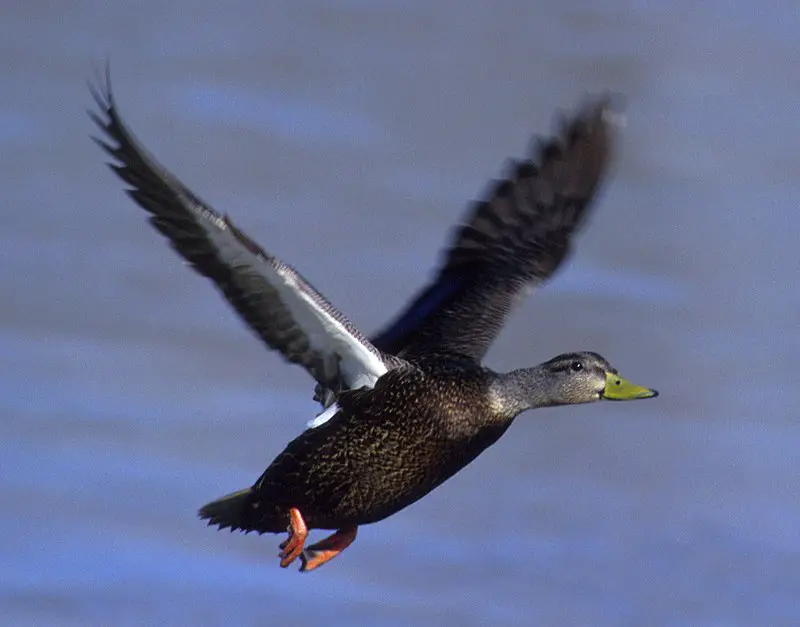
The American black duck is a large dabbling bird found in the Anatidae family. It has a dark brown plumage and measures between 21 to 23 inches in length, with an average wingspan of 35-37 inches.
This species can weigh anywhere from 1.59 – 3.62 lbs on average and are known as one of the heaviest ducks within their genus Anas.
They have similarities to female mallards but are generally darker overall which helps them stand out among other water fowls.
The American Black Duck mainly inhabits wetlands, marshes, lakes, rivers and estuaries across North America making it well suited for its aquatic lifestyle.Scientific classification:
| Kingdom | Animalia |
| Phylum | Chordata |
| Class | Aves |
| Order | Anseriformes |
| Family | Anatidae |
| Genus | Anas |
| Species | A. rubripes |
14. Red-Breasted Nuthatch

The Red-breasted Nuthatch is a beautiful and vocal songbird that can be found in coniferous forests across Canada, Alaska, the northeastern United States and western US.
This small bird has blue-grey upperparts with cinnamon underparts, a white throat and face with black eye stripe, straight grey bill and black crown.
Its call sounds like a tin trumpet; it’s high-pitched yet nasal.
During mating season they form monogamous pairs to build their nest near tree trunks or branches at low heights off the ground where they lay 2 – 8 eggs at once.
They are very active little birds who love clinging to trees while searching for insect larvae or seeds within the bark of trees which helps control pest populations.Scientific classification:
| Kingdom | Animalia |
| Phylum | Chordata |
| Class | Aves |
| Order | Passeriformes |
| Family | Sittidae |
| Genus | Sitta |
| Species | S. canadensis |
Also Featured In: Common Birds in Canada, Birds You’ll Find in Vancouver Island
15. White-Throated Sparrow

The White-throated Sparrow is a small passerine bird of the New World sparrow family Passerellidae.
It has distinctive yellow and black stripes on its head, white throat and chest with grey back and wings, along with light brown legs.
The scientific name “Zonotrichia albicollis” comes from Ancient Greek for ‘band’ (ζώνη) referring to its distinctive striped crown, and Latin for ‘white neck’ (albus collum).
These birds are usually found in wooded areas such as coniferous forests or deciduous habitats in North America where they feed mainly on insects during summer months; transitioning to seeds during winter.
They build their nests near ground level using grasses, twigs or moss lined with feathers.
White-throated Sparrows may be solitary but also form flocks when migrating southward each fall season which typically occurs over mid-late October through November depending on location within range.Scientific classification:
| Kingdom | Animalia |
| Phylum | Chordata |
| Class | Aves |
| Order | Passeriformes |
| Family | Passerellidae |
| Genus | Zonotrichia |
| Species | Z. albicollis |
Also Featured In: Birds of Taiga, Yellow Georgia Birds
16. Song Sparrow

The Song Sparrow (Melospiza melodia) is a small, yet abundant bird found in North America.
They have brown upperparts with dark streaks and are white underneath, complete with a distinct dark brown spot on the breast.
Their cap is also brown and long roughed feathers can be seen sprouting from their neck area.
This sparrow species is highly variable and adaptable to many different environments including dry brush land, wetlands or open fields.
It has been noted that adult song sparrows will sing even during winter months when other birds remain quiet.
These energetic little animals make for great backyard companions as they flit about singing their lovely melodies.Scientific classification:
| Kingdom | Animalia |
| Phylum | Chordata |
| Class | Aves |
| Order | Passeriformes |
| Family | Passerellidae |
| Genus | Melospiza |
| Species | M. melodia |
Also Featured In: Common Vermont Winter Birds, Small Birds Live in Vermont
17. Pileated Woodpecker
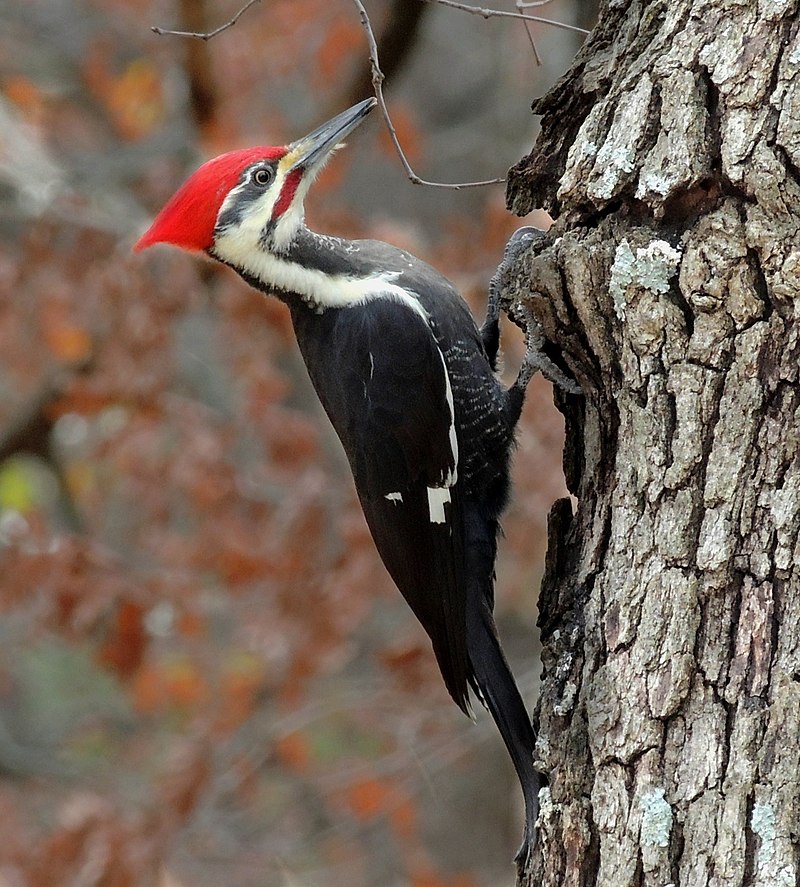
The pileated woodpecker is a large, majestic bird native to North America.
Its striking black plumage and red crest make it an unmistakeable sight in the forest canopy of deciduous forests across eastern North America, Great Lakes region, Canada’s boreal forests, and parts of the Pacific Coast.
It is one of the largest woodpeckers in North America: larger than any other confirmed species except for perhaps its relative; the ivory-billed woodpecker.
Insectivorous by nature, this stunning creature can be seen pecking away at tree trunks searching for food or making nest cavities – all with remarkable skill.
The pileated woodpecker truly stands out as a symbol of beauty and resilience amongst our avian wildlife.Scientific classification:
| Kingdom | Animalia |
| Phylum | Chordata |
| Class | Aves |
| Order | Piciformes |
| Family | Picidae |
| Genus | Dryocopus |
| Species | D. pileatus |
Also Featured In: Red Birds You’ll See in Oklahoma, Red Birds You’ll Commonly Found in Texas
18. Pine Grosbeak
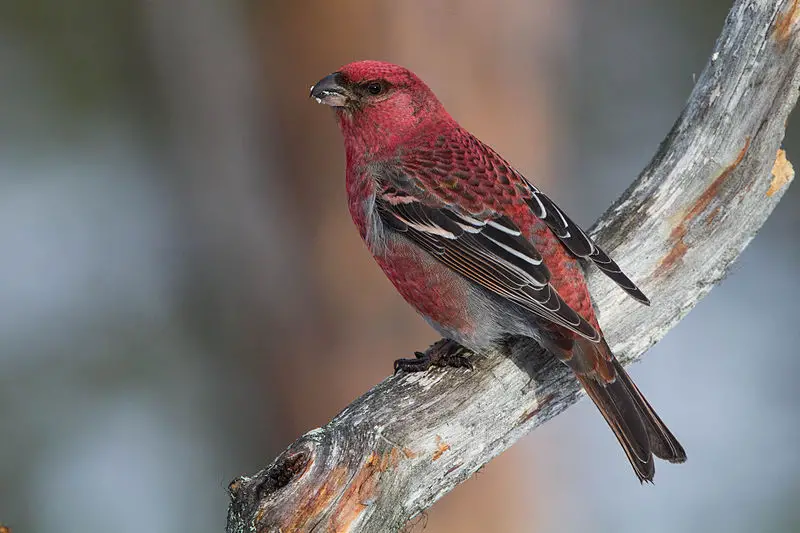
Pine grosbeak is a beautiful bird found across Alaska, western US, Canada and Fennoscandia to Siberia. It belongs to the family of true finch and it is the only species in its genus Pinicola.
This frugivorous bird has bright red feathers on its head and wings with yellowish white underparts that make it very attractive.
During winter season they feed mostly on small fruits like rowans, blueberries etc., while during summer months their diet consists mainly of insects.
They are shy birds but can be seen perched at high branches or singing from the topmost trees if you look carefully enough.Scientific classification:
| Kingdom | Animalia |
| Phylum | Chordata |
| Class | Aves |
| Order | Passeriformes |
| Family | Fringillidae |
| Subfamily | Carduelinae |
| Genus | Pinicola Vieillot, 1808 |
| Species | P. enucleator |
Also Featured In: Spiritual Birds, Mountain Birds You Should Know
19. Pine Warbler
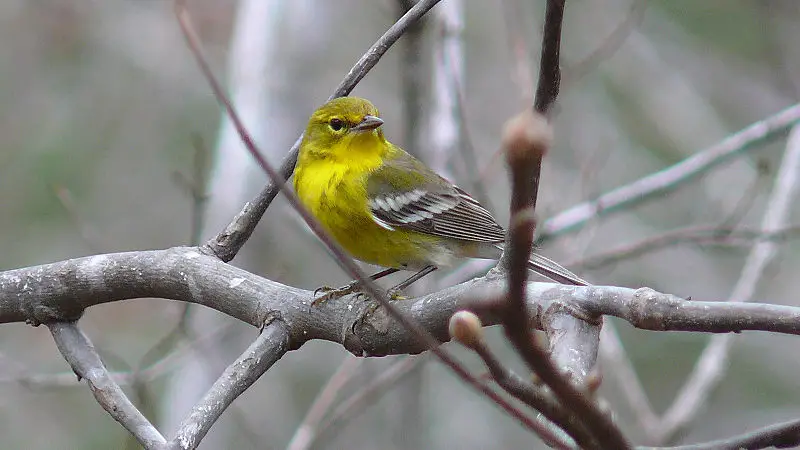
The Pine Warbler is a small bird from the New World warbler family, with an olive-brown upperparts and white belly.
Its distinguishing features include two white wing bars, dark legs, thin pointed bills and yellowish ‘spectacles’ around its eyes.
Adult males have bright yellow throats and breasts on top of their olive upperparts; females and immatures are less vibrant in colour but retain similar characteristics.
These birds can be found near pine forests throughout North America during summer months before migrating to warmer climates for winter.
They feed mainly on insects such as caterpillars, spiders and flies while also consuming fruits like blueberries when food becomes scarce in colder times of year.
All in all, these tiny songbirds provide us with much beauty through their unique plumage patterns whilst serving important roles within their ecosystems.Scientific classification:
| Kingdom | Animalia |
| Phylum | Chordata |
| Class | Aves |
| Order | Passeriformes |
| Family | Parulidae |
| Genus | Setophaga |
| Species | S. pinus |
Also Featured In: Most Common Types of Birds Found in Cuba, Common Yellow Birds of Idaho
20. Northern Gannet
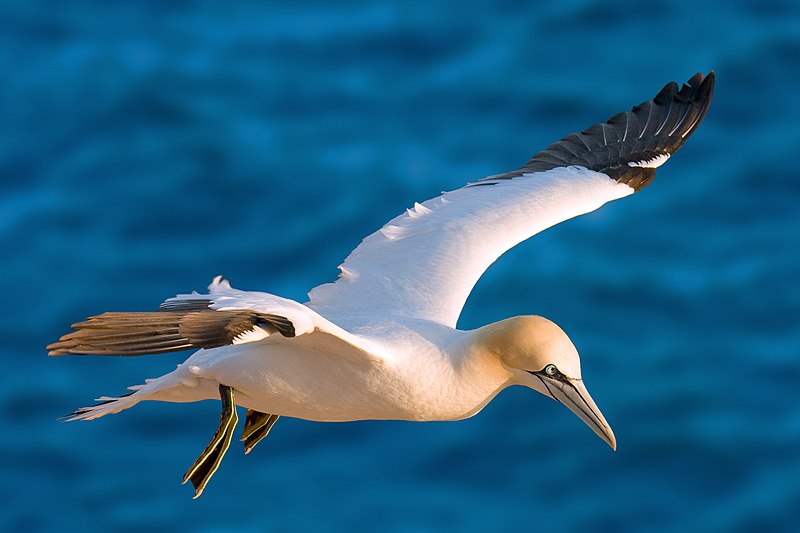
The Northern Gannet is the largest species of seabird in the northern Atlantic, with a white body and long neck.
It has yellowish head feathers and black tipped wings that can reach up to 6 feet across when fully extended.
The beak is large and orange-yellow in color. This bird breeds along western Europe’s coasts as well as northeastern North America.
They forage for fish by plunging into the sea from high above, making them an impressive sight to behold on any given day.
Their diet consists mainly of herring, mackerels or sand eels which they catch midair after diving at speeds reaching over 100 miles per hour.
With their striking features these birds are truly majestic creatures that have been around since prehistoric times – a testament to their hardiness and adaptability.Scientific classification:
| Kingdom | Animalia |
| Phylum | Chordata |
| Class | Aves |
| Order | Suliformes |
| Family | Sulidae |
| Genus | Morus |
| Species | M. bassanus |
Also Featured In: Birds found in portugal, Birds You’ll Find in the Sea
21. Red-Headed Woodpecker
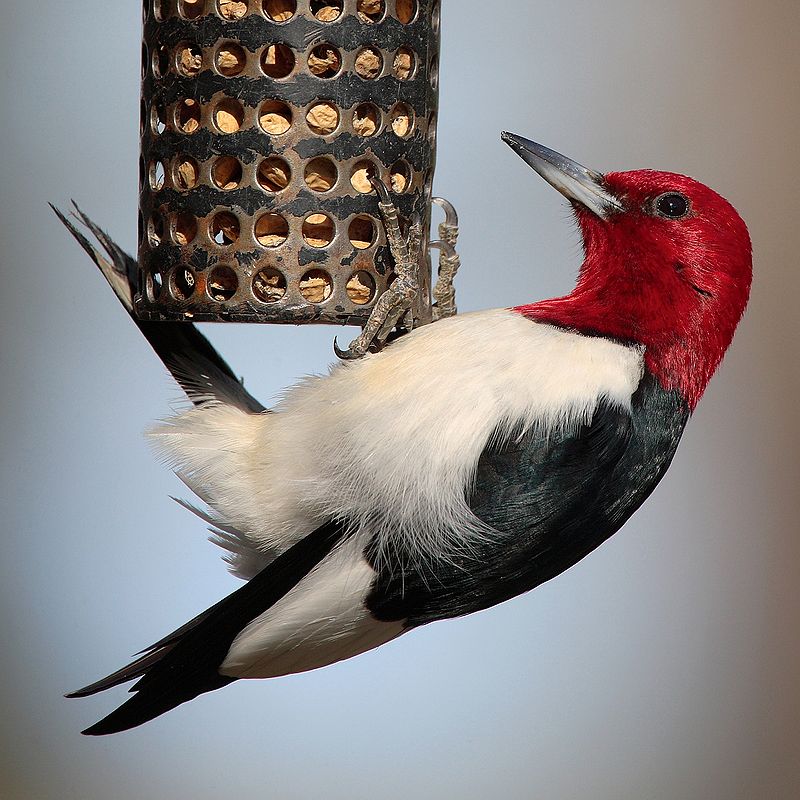
The red-headed woodpecker is a mid-sized bird found in temperate North America. It has striking plumage, with its head and neck being bright red while the rest of its body is primarily black and white.
Its wings are rounder than other similar species, allowing it to maneuver through tight spaces easily when searching for food or shelter.
The breeding habitat of this bird consists mainly of open fields across Canada and the east-central United States.
Despite facing threats such as deforestation, urbanization, predation from larger birds, collisions with windows or cars due to their inquisitive nature.
These birds remain listed on IUCN’s Red List as least concern thanks largely in part to conservation efforts by local governments and organizations dedicated to protecting wildlife habitats.Scientific classification:
| Kingdom | Animalia |
| Phylum | Chordata |
| Class | Aves |
| Order | Piciformes |
| Family | Picidae |
| Genus | Melanerpes |
| Species | M. erythrocephalus |
Also Featured In: Georgia Birds, Red Birds that Live in Tennessee
22. Purple Finch

The Purple Finch is a species of finch from North America, belonging to the Fringillidae family.
It’s also known as an “American Rosefinch” due to its resemblance in color and size to some European rosefinches.
Their plumage ranges from pinkish-purple on their heads and wings, with a light brown underside.
They are small birds that measure about 5-6 inches long with short thin beaks for eating seeds and insects.
In addition, they have thick round bodies which help them stay warm during cold winters in the northern parts of their range.
The Purple Finch has adapted well over time making it easier for them to survive even though there are increasing threats posed by humans such as deforestation or habitat destruction caused by development projects near their habitats.Scientific classification:
| Kingdom | Animalia |
| Phylum | Chordata |
| Class | Aves |
| Order | Passeriformes |
| Family | Fringillidae |
| Subfamily | Carduelinae |
| Genus | Haemorhous |
| Species | H. purpureus |
Also Featured In: Magenta Birds You Didn’t Know, Adirondack Mountain Birds
23. Cooper’s Hawk
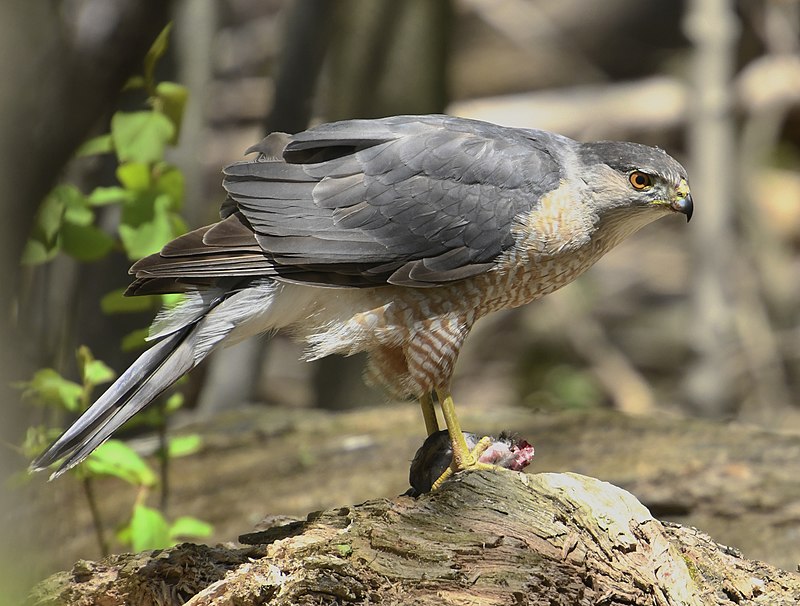
Cooper’s Hawk is a medium-sized bird of prey native to North America. It belongs to the Accipiter genus, which are known for their agility and small size compared to other hawks.
They usually inhabit wooded areas, making them well-adapted hunters in dense environments.
Cooper’s Hawks have rounded wings with short tails that help them maneuver quickly through trees when chasing after prey such as small rodents or birds.
These raptors also possess powerful feet equipped with sharp talons used for catching food items on the ground and even out of midair.
The adult plumage has barred upperparts, ranging from greyish brown on lighter individuals up to dark chestnut colors found in darker specimens; they also display rusty underparts marked by thin white streaking down either side of their chests and bellies.Scientific classification:
| Kingdom | Animalia |
| Phylum | Chordata |
| Class | Aves |
| Order | Accipitriformes |
| Family | Accipitridae |
| Genus | Accipiter |
| Species | A. cooperii |
Also Featured In: Birds that Live in the Deserts, Winter Birds of Illinois
24. Common Redpoll
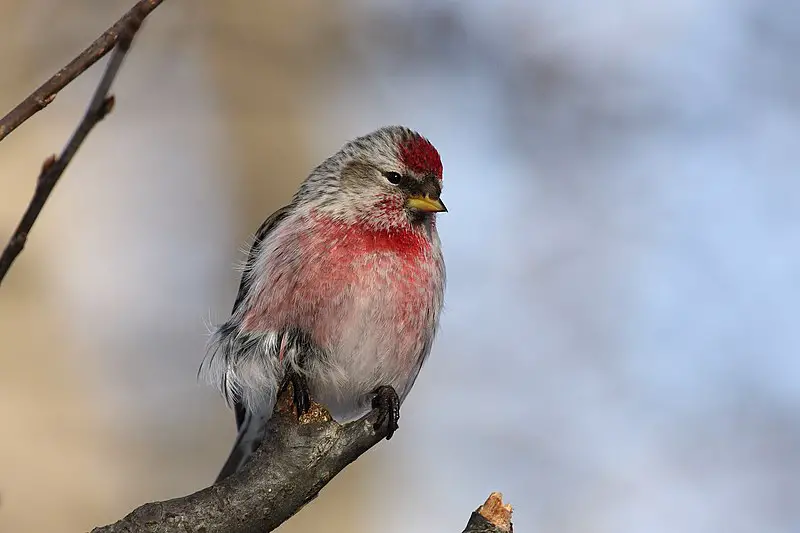
The Common Redpoll is a species of bird belonging to the finch family. It has an orange-red crown, white breast and grey back with two black stripes running down either side.
Its wings are barred in browns and its tail feathers have a grayish tinge at their tips. The redpoll breeds mainly south from Arctic regions in habitats that contain shrubs or thickets.
First classified by Linnaeus in 1758 under the binomial name Fringilla flammea, it’s genus Acanthis originates from Ancient Greek akantha meaning “thorn” or “prickle”.
This small yet colourful bird feeds mainly on seeds such as thistles during summer months but switches over to birch catkins when winter arrives – making them a common sight throughout much of North America and Eurasia.Scientific classification:
| Kingdom | Animalia |
| Phylum | Chordata |
| Class | Aves |
| Order | Passeriformes |
| Family | Fringillidae |
| Subfamily | Carduelinae |
| Genus | Acanthis |
| Species | A. flammea |
Also Featured In: Finches Species, Most Common Winter Birds
25. Red Crossbill
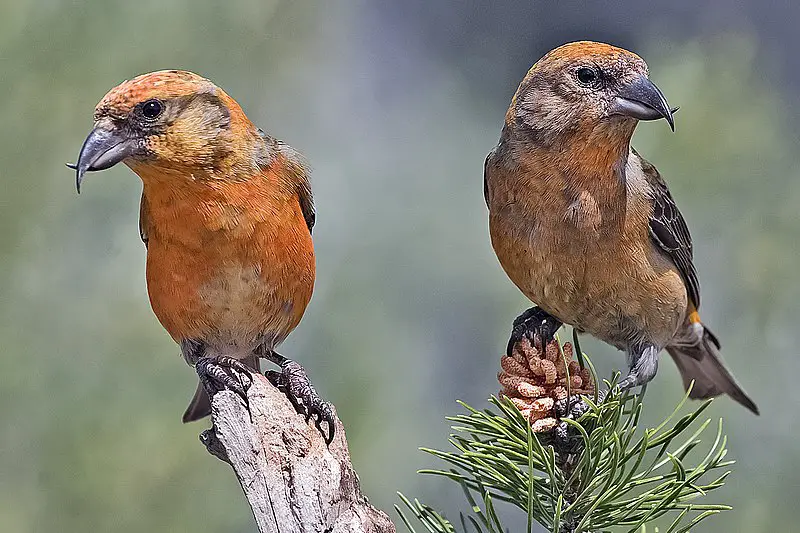
The Red Crossbill is a small passerine bird belonging to the finch family. It has distinctively crossed mandibles, which it uses to extract seeds from conifer cones and other fruits.
This species can be identified by its vivid colouring; males are red or orange in hue whilst females tend to have more green or yellow feathers.
Furthermore, there is considerable variation between individuals of this species when it comes to their beaks size and shape as well as their calls—which range from short trills through chirps and harsh cackles up until loud rattling sounds at times.
They’re an interesting sight in many parts of Europe, particularly during winter months where they often feed on pine cone seeds that drop down onto lower branches of trees.Scientific classification:
| Kingdom | Animalia |
| Phylum | Chordata |
| Class | Aves |
| Order | Passeriformes |
| Family | Fringillidae |
| Subfamily | Carduelinae |
| Genus | Loxia |
| Species | L. curvirostra |
Also Featured In: Common Birds in Saskatchewan, Common Birds in Alberta
26. Pine Siskin
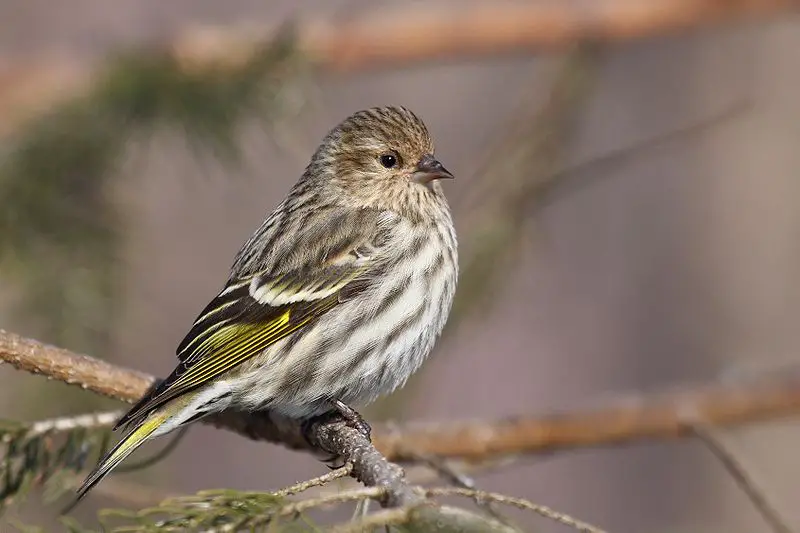
The Pine Siskin is a small bird from the finch family, primarily found in North America. It has an irregular migratory range and was first described by American ornithologist Alexander Wilson in 1810.
The species gets its name pinus, which means “pine-tree” in Latin, due to its frequent presence near coniferous trees.
Pine siskins are known for their yellow wing bars and streaked chests as well as their perky mannerisms when perched on branches or flying around looking for food during colder months.
They feed mostly on seeds of weeds, grasses and other plants but can also be seen consuming insects at times during summertime nesting season.
Its loud calls often alert nearby birds of potential danger while they nest high up among pine tree limbs where predators cannot reach them easily.Scientific classification:
| Kingdom | Animalia |
| Phylum | Chordata |
| Class | Aves |
| Order | Passeriformes |
| Family | Fringillidae |
| Subfamily | Carduelinae |
| Genus | Spinus |
| Species | S. pinus |
Also Featured In: Autumn Birds You Should Know, Birds that Live in Mississippi
27. Evening Grosbeak
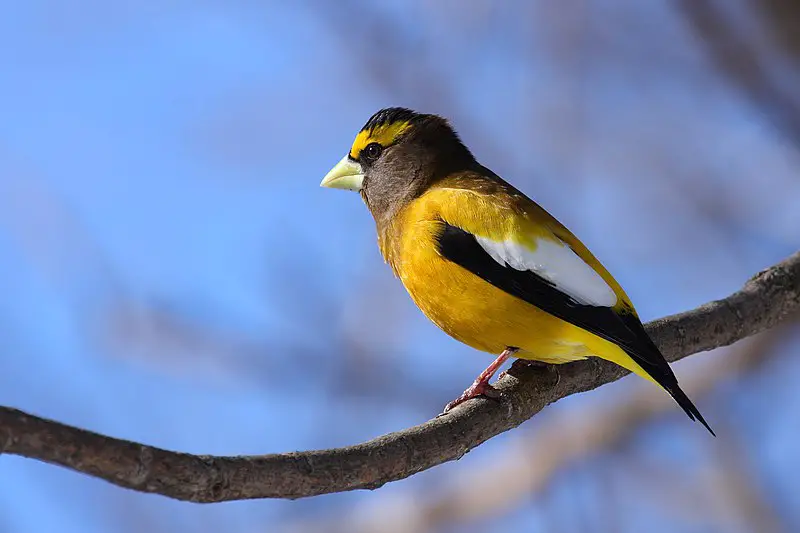
The Evening Grosbeak (Hesperiphona vespertina) is a beautiful passerine bird in the finch family Fringillidae native to North America.
It has an impressive wingspan of up to 20 inches and its plumage is mostly black, yellow or grey with distinctive white patches on each side of its head.
Its diet consists mainly of seeds and other plant matter as well as small insects, fruit and berries when available.
The male’s song is loud and melodic which can be heard from some distance away during breeding season making it a popular species for avid backyard birders.
The Evening Grosbeak typically nests high in coniferous trees where they build cup-shaped structures lined with feathers or grass that provide protection against predators.
Overall this species makes an excellent addition to any backyard aviary.Scientific classification:
| Kingdom | Animalia |
| Phylum | Chordata |
| Class | Aves |
| Order | Passeriformes |
| Family | Fringillidae |
| Subfamily | Carduelinae |
| Genus | Hesperiphona |
| Species | H. vespertina |
Also Featured In: New Hampshire Birds You Should Know, Yellow Connecticut Birds
28. Two-Barred Crossbill
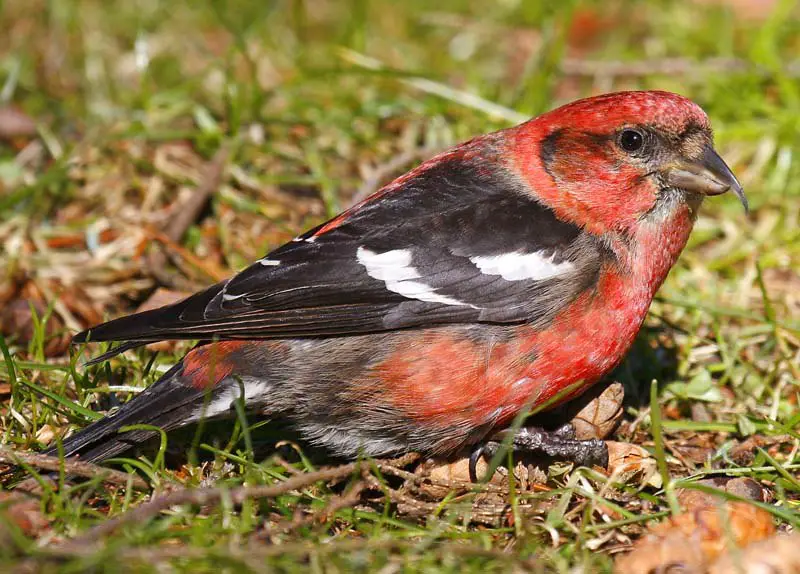
The Two-barred crossbill is a small passerine bird belonging to the finch family Fringillidae.
It gets its scientific name, Loxia leucoptera, from Ancient Greek – with ‘Loxia’ meaning ‘crosswise’ and ‘leucoptera’ translating to “white-winged” in reference to its white wings.
The species has two subspecies: the white-winged crossbill (Loxia leucoptera leucoptera) that can be found in North America and the two bar crossbill (Loxia leucocephala) which inhabits Europe, Asia as well as parts of northern Africa.
These birds feed mainly on conifer seeds but have also been seen consuming insects such as beetles or caterpillars during breeding season when food resources are scarce for their young ones.
They construct nests made out of twigs near trunks of spruce trees where they lay 2–6 eggs at one time.Scientific classification:
| Kingdom | Animalia |
| Phylum | Chordata |
| Class | Aves |
| Order | Passeriformes |
| Family | Fringillidae |
| Subfamily | Carduelinae |
| Genus | Loxia |
| Species | L. leucoptera |
Also Featured In: Birds that Migrate through Illinois in the Spring, Red birds You’ll See in Arizona
29. Arctic Redpoll
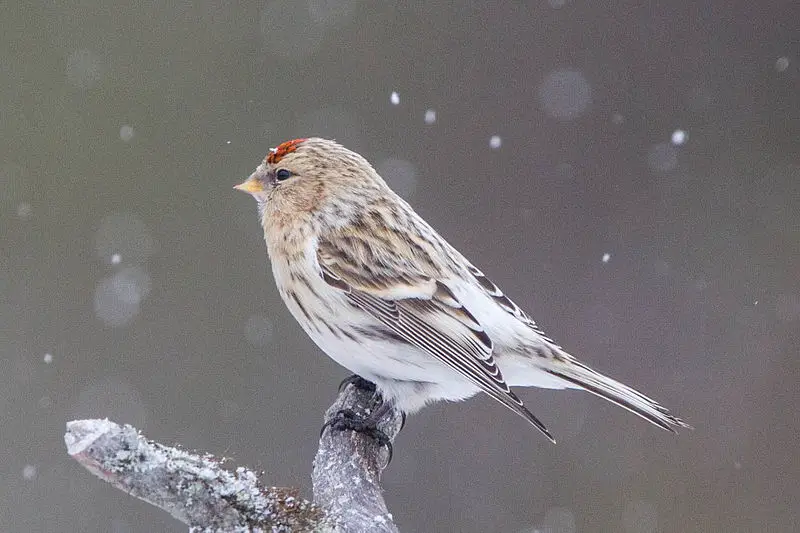
The Arctic redpoll, also known as hoary redpoll, is a species of bird in the finch family.
It breeds mostly in tundra birch forests and has two subspecies- Hornemann’s Arctic Redpoll found primarily in Greenland and neighbouring parts of Canada while Coues’ arctic redpoll can be seen breeding across Northern North America and Palearctic regions.
This small songbird nests on the ground or low shrubs during summer months before migrating south for winter season.
Its main diet consists of seeds but it may occasionally eat insects like caterpillars to supplement its nutrition needs.
These birds have reddish plumage with white patches on their wings which offer them great camouflage against predators such as hawks when they are perched amongst trees or flying over snow covered grounds respectively.Scientific classification:
| Kingdom | Animalia |
| Phylum | Chordata |
| Class | Aves |
| Order | Passeriformes |
| Family | Fringillidae |
| Subfamily | Carduelinae |
| Genus | Acanthis |
| Species | A. hornemanni |
Also Featured In: Birds that Live in Greenland, Tundra Birds
30. American Tree Sparrow
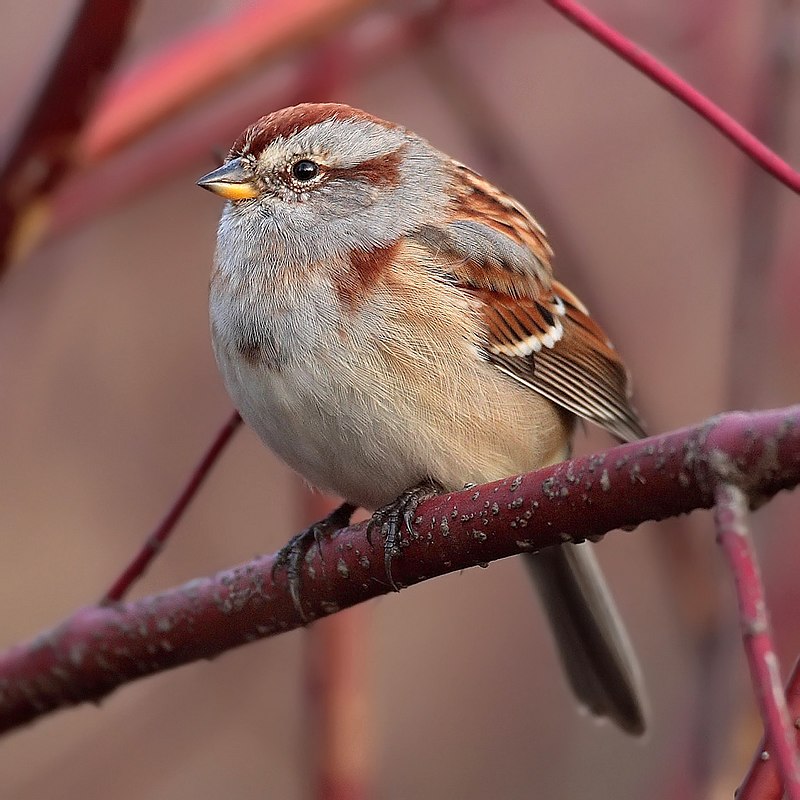
The American tree sparrow, also known as the winter sparrow, is a medium-sized New World bird. It has an attractive rusty cap and grey underparts with a small dark spot on its chest.
Its back is rust colored and striped with lighter shades of brown while its wings have various shades of browns.
These birds are usually found in open areas such as grasslands or marshland during spring migration and can form large flocks when seeking food sources like seeds, insects or berries.
They nest in shrubs or trees near water sources but rarely do so far away from human settlements due to their dependence on supplementary foods provided by humans.
The American Tree Sparrow is a delightful sight for any nature enthusiast.Scientific classification:
| Kingdom | Animalia |
| Phylum | Chordata |
| Class | Aves |
| Order | Passeriformes |
| Family | Passerellidae |
| Genus | Spizelloides Slager & Klicka, 2014 |
| Species | S. arborea |
Also Featured In: Sparrows Species, Birds Commonly Found in New York
31. White-Crowned Sparrow
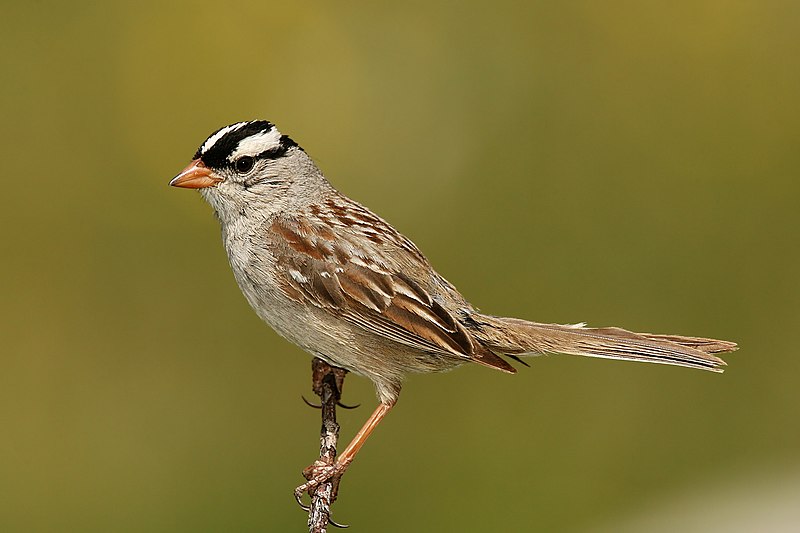
The White-crowned Sparrow is a species of passerine bird native to North America. It has a grey face and black and white streaking on its upper head, making it easy to identify.
This sparrow usually breeds in brushy areas located in the taiga, tundra, Rocky Mountains or Pacific coast regions of North America.
During winter months these birds migrate southward as far as Mexico and California where they can be found living amongst chaparral shrubbery or low bushes near open fields with plenty of seeds nearby.
The diet of this bird consists mainly of insects during summer while they switch over to eating grains like wheat & oats during colder months when bugs are scarce.
They are known for their characteristic chirp which sounds like “Oh sweet Canada Canada” drawing admirers from around the world.Scientific classification:
| Kingdom | Animalia |
| Phylum | Chordata |
| Class | Aves |
| Order | Passeriformes |
| Family | Passerellidae |
| Genus | Zonotrichia |
| Species | Z. leucophrys |
Also Featured In: Most Common Songs Birds that Live around You, Common Southern Californian Birds
32. Savannah Sparrow
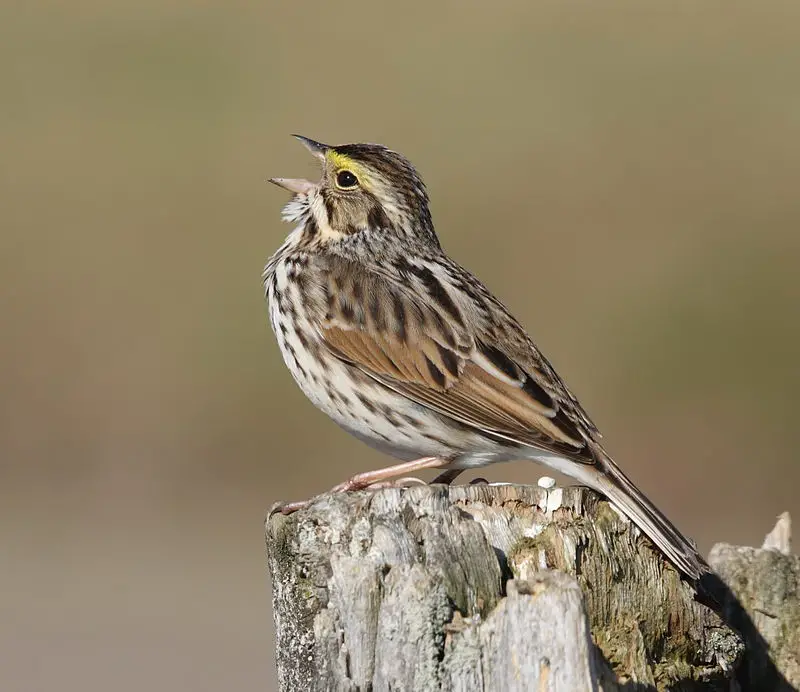
The Savannah Sparrow is a small, New World sparrow. It’s the only bird in its genus, Passerculus and can be distinguished from other similar species by comparing mtDNA NADH dehydrogenase subunit 2 and 3 sequences.
Its closest relative is the Ipswich sparrow which was once considered an independent species but now it’s seen as being part of the same family as this bird.
The male has yellowish-brown upper parts with darker streaks, white underparts with dark streaking on breast and flanks, orange wash to face sides plus two bold wingbars.
Females are slightly duller than males with less distinct markings on wings yet still showing some degree of variation between individuals across their range.Scientific classification:
| Kingdom | Animalia |
| Phylum | Chordata |
| Class | Aves |
| Order | Passeriformes |
| Family | Passerellidae |
| Genus | Passerculus |
| Species | P. sandwichensis |
Also Featured In: Savanna Birds You Need to See, Birds that Live in the Grasslands
33. Lincoln’s Sparrow
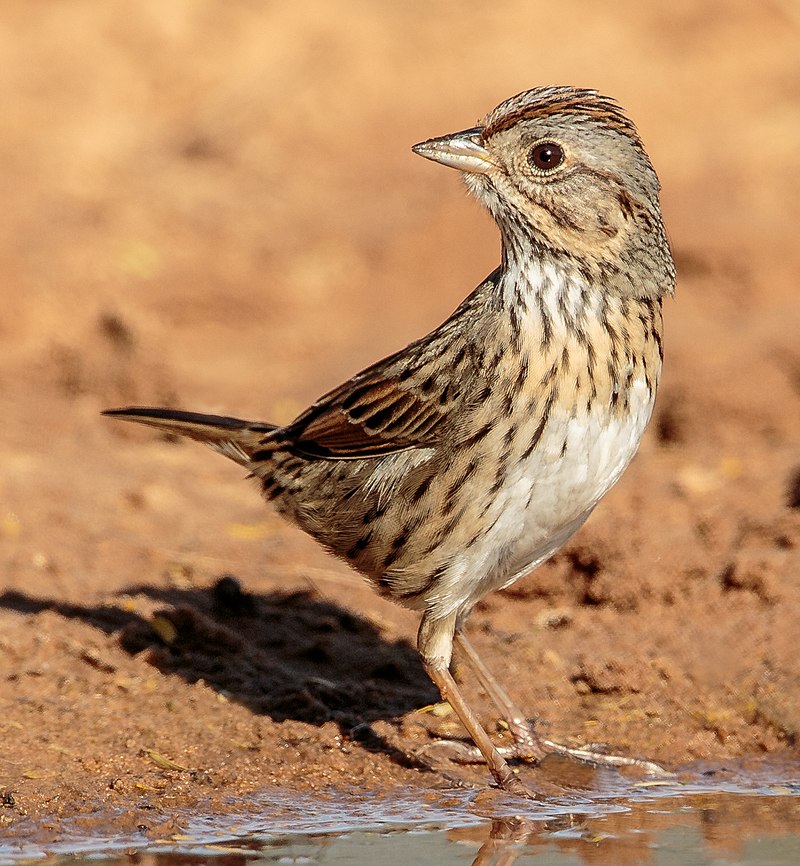
Lincoln’s sparrow is a small passerine bird native to North America. It has brown upperparts, white underparts and a distinctive light-gray eyebrow line above its eyes.
The species usually stays hidden in thick ground cover but can be identified by its sweet, wrenlike song.
Lincoln’s sparrow belongs to the genus Melospiza along with two other species: the Song Sparrow (M.melodia) and Swamp Sparrow (M. georgiana).
This elusive yet beautiful bird inhabits well-covered areas such as wetlands, grasslands, shrubland valleys, pastures and open woodlands across most of Canada and parts of northern USA throughout summer months before migrating south for winter season.Scientific classification:
| Kingdom | Animalia |
| Phylum | Chordata |
| Class | Aves |
| Order | Passeriformes |
| Family | Passerellidae |
| Genus | Melospiza |
| Species | M. lincolnii |
Also Featured In: Birds You’ll Find in South Texas , Birds in Pacific Northwest
34. Swamp Sparrow
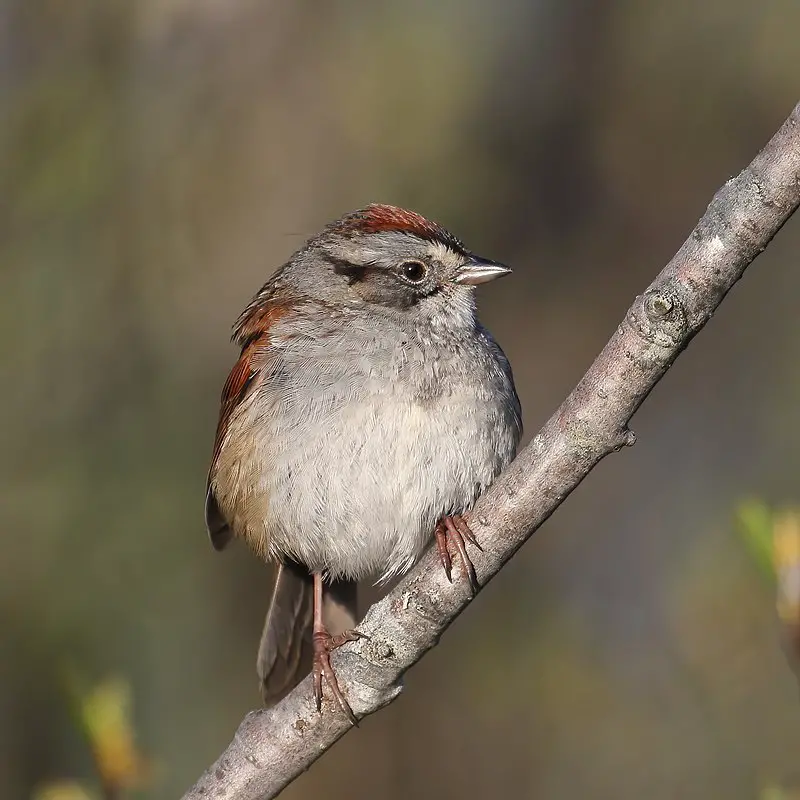
The Swamp Sparrow is a medium-sized bird found in the New World, closely related to the Song Sparrow.
It has rusty and buff streaked upperparts with an unstreaked gray breast, light belly, white throat and striking rusty wings.
The male’s head features a rust-coloured cap while both genders have grey faces with dark lines through their eyes.
Their bills are short and conical in shape which helps them feed on seeds as well as grains easily from ground or low vegetation.
They usually appear solitary but can also be seen foraging together near waterbodies such as swamps or marshes during migration season.Scientific classification:
| Kingdom | Animalia |
| Phylum | Chordata |
| Class | Aves |
| Order | Passeriformes |
| Family | Passerellidae |
| Genus | Melospiza |
| Species | M. georgiana |
Also Featured In: Swamps Birds You Should Know, Birds that can be Seen in October
35. Field Sparrow
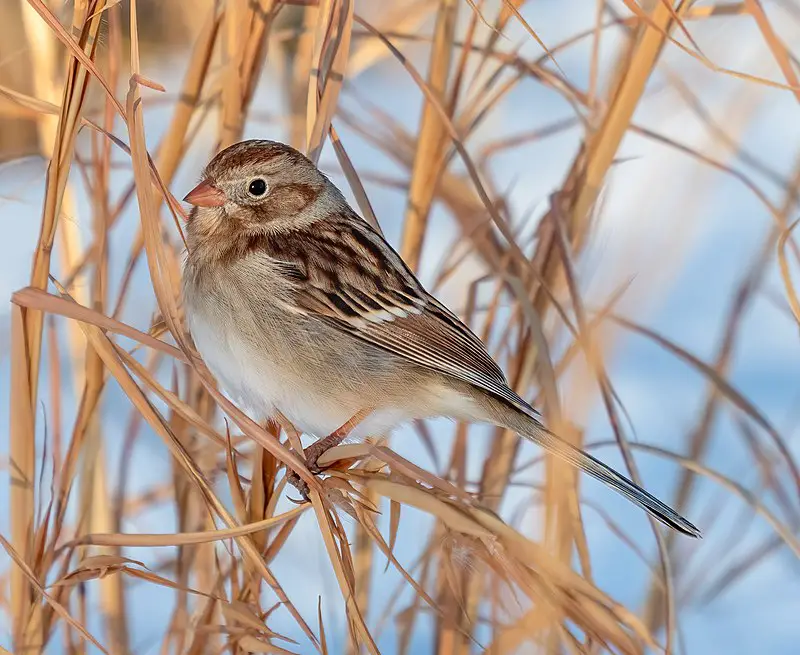
The Field Sparrow is a small bird that can be found across North America. It has a gray head with rust-colored crown and white eye-ring, while its upper parts are brown streaked with black and buff feathers.
Its breast is buff colored, belly white, and the tail forked. There are two color morphs of this species; one being darker in color than the other.
They measure about 140 mm long and weigh 12.5 grams on average; feeding primarily on seeds from grasses or weeds as well as insects during summer months.
The field sparrow’s song is often described as sweet whistles which it sings from an exposed perch like fence posts or trees tops.Scientific classification:
| Kingdom | Animalia |
| Phylum | Chordata |
| Class | Aves |
| Order | Passeriformes |
| Family | Passerellidae |
| Genus | Spizella |
| Species | S. pusilla |
Also Featured In: Small Kentucky Birds, Brown Birds that Live in West Virginia
36. Yellow-Bellied Sapsucker
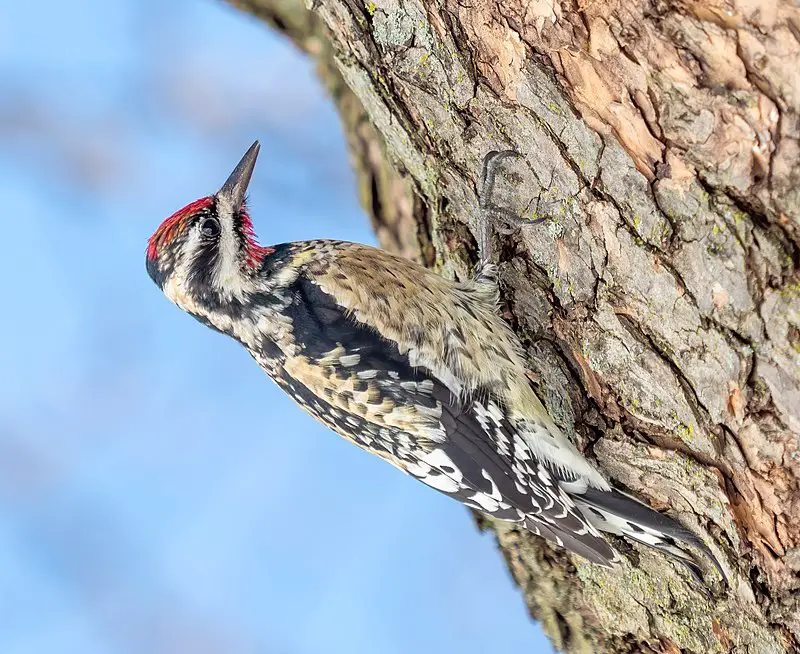
The Yellow-bellied Sapsucker is a medium sized woodpecker that can be found in Canada and the northeastern United States.
It was first described by English naturalist Mark Catesby who illustrated it with hand coloured plates for his book The Natural History of Carolina, Florida and the Bahama Islands during 1729 -1732.
This beautiful bird has white stripes on its black head which contrast against its yellow throat, breast and belly making it stand out from other birds. Its wings are barred with red patches adding to their beauty.
They also have white streaks on their sides along with bold spots at their back giving them an unique look among others.Scientific classification:
| Kingdom | Animalia |
| Phylum | Chordata |
| Class | Aves |
| Order | Piciformes |
| Family | Picidae |
| Genus | Sphyrapicus |
| Species | S. varius |
Also Featured In: Woodpeckers Species, Long Island Birds You Should Know
37. Black-Backed Woodpecker
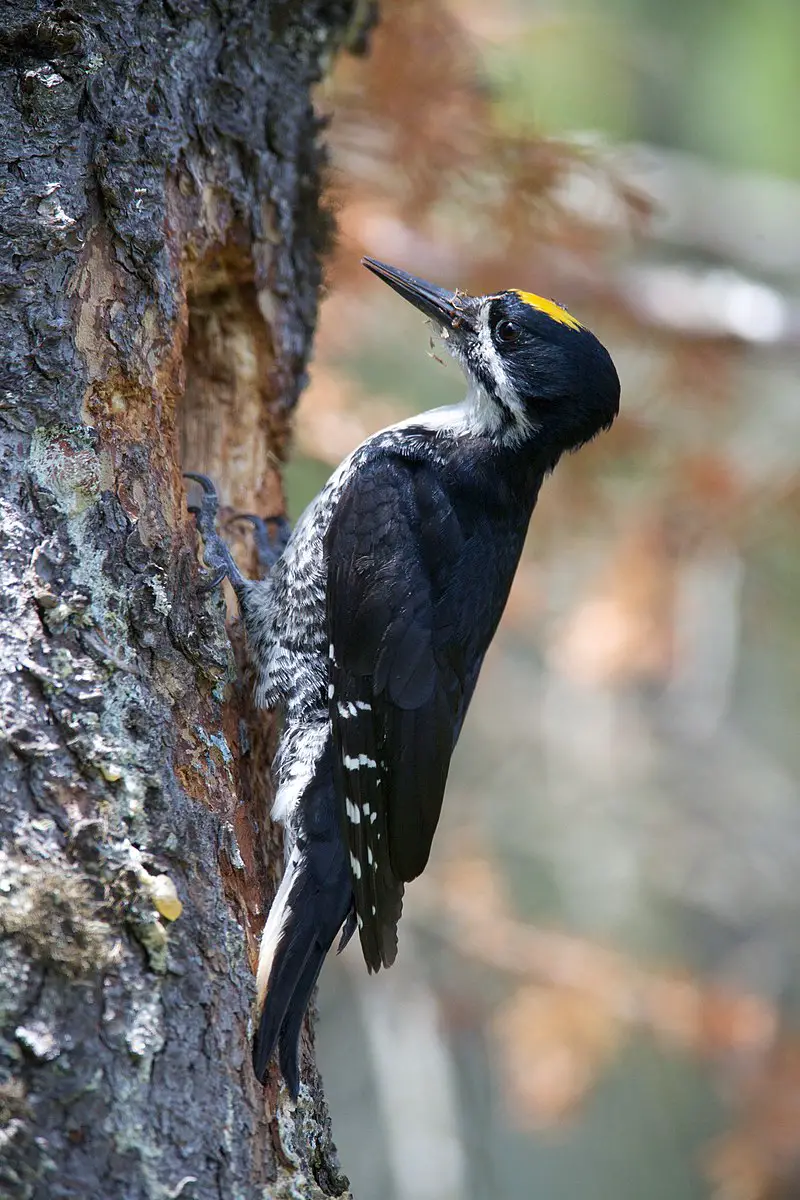
The Black-backed Woodpecker (Picoides arcticus) is a medium sized bird found in the forests of North America. It has black upperparts and white underparts, with three toes on each foot.
The species was first described by English naturalist William John Swainson in 1832 from a specimen collected near the source of the Athabasca River on its eastern slopes. Its diet consists mainly of insects, larvae, and carrion.
They are often seen searching for food while clinging to tree trunks or branches like other woodpeckers do; they also excavate cavities in dead trees which provide them shelter during cold weathers as well as nesting sites for their young ones.
These birds have adapted to survive even at temperatures below zero degrees Celsius due to their thick feather coat which keeps them warm despite extreme weather conditions that occur in higher elevation areas where these birds typically reside.Scientific classification:
| Kingdom | Animalia |
| Phylum | Chordata |
| Class | Aves |
| Order | Piciformes |
| Family | Picidae |
| Genus | Picoides |
| Species | P. arcticus |
Also Featured In: Small Birds Of Illinois,
38. Winter Wren
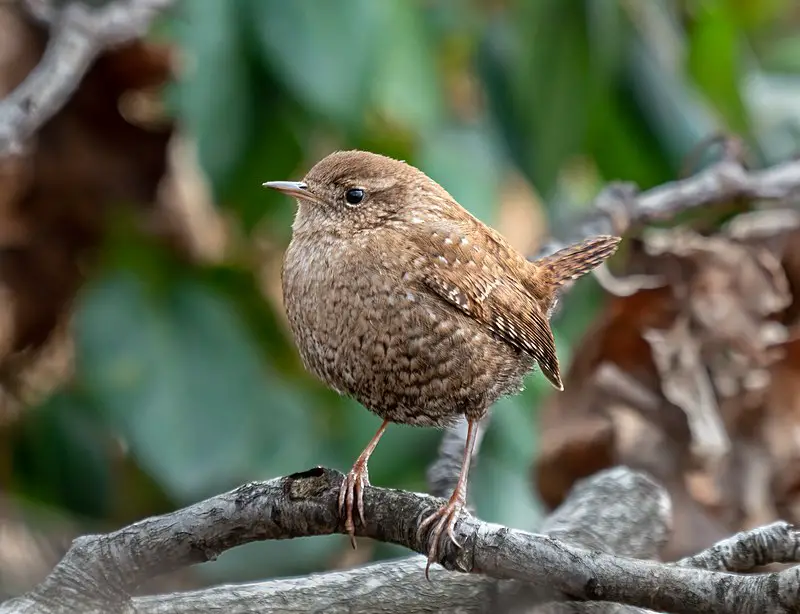
The Winter Wren is a tiny bird belonging to the New World wren family. It can be found in North America, from British Columbia all the way to the Atlantic Ocean.
In winter, it migrates south and sometimes even reaches Central America. Its habitat consists mainly of coniferous forests where it builds its nest on or near ground level within dense vegetation for protection against predators.
This small songbird has a rich brown plumage with white eyebrows and buff underparts which helps them blend into their environment perfectly.
The Winter Wrens are renowned for their loud songs that they sing both day and night during breeding season; making them an integral part of any forest ecosystem.Scientific classification:
| Kingdom | Animalia |
| Phylum | Chordata |
| Class | Aves |
| Order | Passeriformes |
| Family | Troglodytidae |
| Genus | Troglodytes |
| Species | T. hiemalis |
Also Featured In: Wrens Species, North Carolina Mountain Birds
39. Marsh Wren
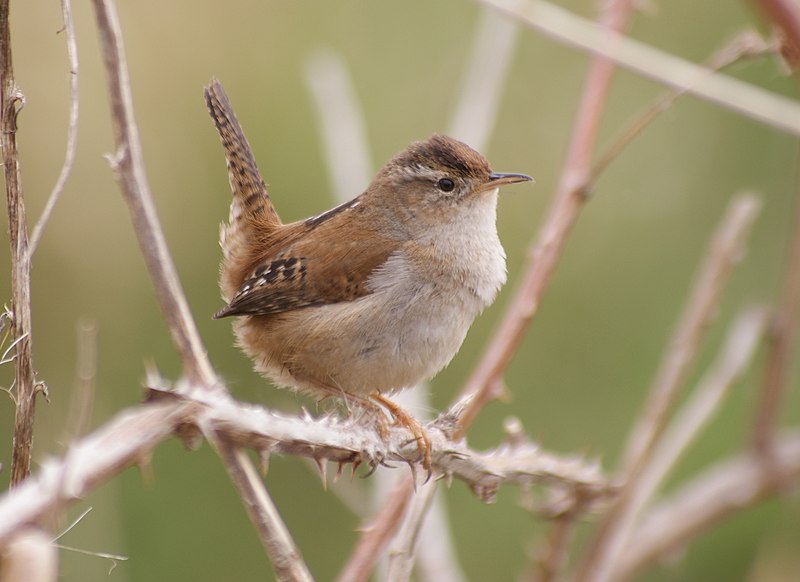
The Marsh Wren is a small bird native to North America, belonging to the wren family. It has a long bill and can be distinguished from other species of marsh birds such as the sedge wren by its size.
The Marsh Wren was first described in 1810 by Alexander Wilson under the binomial name Certhia palustris and now belongs to genus Cistothorus.
This songbird prefers wetland habitats like marshes, swamps or wetlands with dense vegetation for sheltering and nesting activities.
They build nests on grasses near water bodies which are made out of twigs attached at one end forming an enclosed cup-like structure lined with feathers or fur making it look like a woven basket.Scientific classification:
| Kingdom | Animalia |
| Phylum | Chordata |
| Class | Aves |
| Order | Passeriformes |
| Family | Troglodytidae |
| Genus | Cistothorus |
| Species | C. palustris |
Also Featured In: Wetlands Birds You Should Know, Brown Birds that are Found in Mississippi
40. Orange-Crowned Warbler
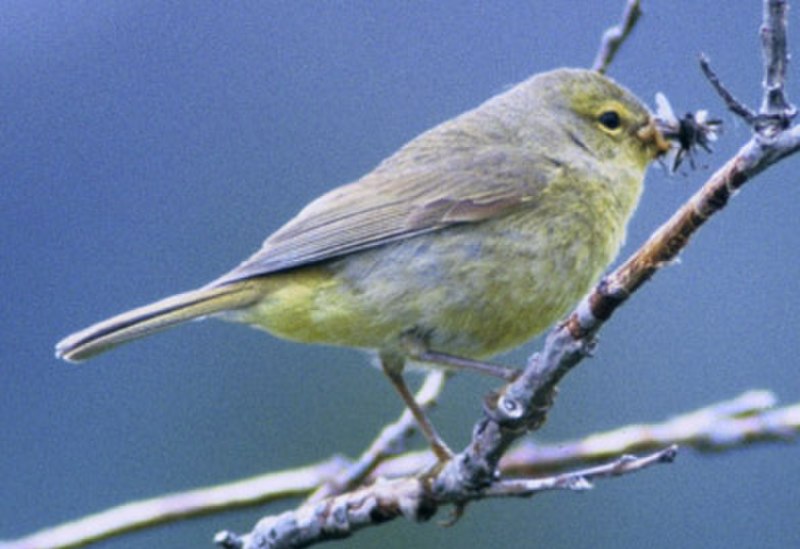
The Orange-crowned Warbler is a small songbird from the New World warbler family. It was formally described in 1822 by Thomas Say, who gave it its scientific name Sylvia celatus – Latin for ‘cloaked’.
This species has an olive green back and wings with yellowish underparts. The males have bright orange crowns during breeding season, which give this bird its namesake.
They can be found mainly in North America but they also migrate to Central America during winter months.
Their diet consists of insects such as butterflies, moths, grasshoppers and beetles; they may also consume fruits occasionally when available.
These birds are relatively quiet except for their mating calls which include whistles or buzzing sounds that last a few seconds long each time.
The Orange-crowned Warbler is one of the most wide spread passerines today due to their hardiness and adaptability; however there remains threat of habitat destruction that could affect many populations negatively if not addressed soon enough.Scientific classification:
| Kingdom | Animalia |
| Phylum | Chordata |
| Class | Aves |
| Order | Passeriformes |
| Family | Parulidae |
| Genus | Leiothlypis |
| Species | L. celata |
Also Featured In: Texas Birds, Phoenix Birds You Should Know
41. Sharp-Shinned Hawk
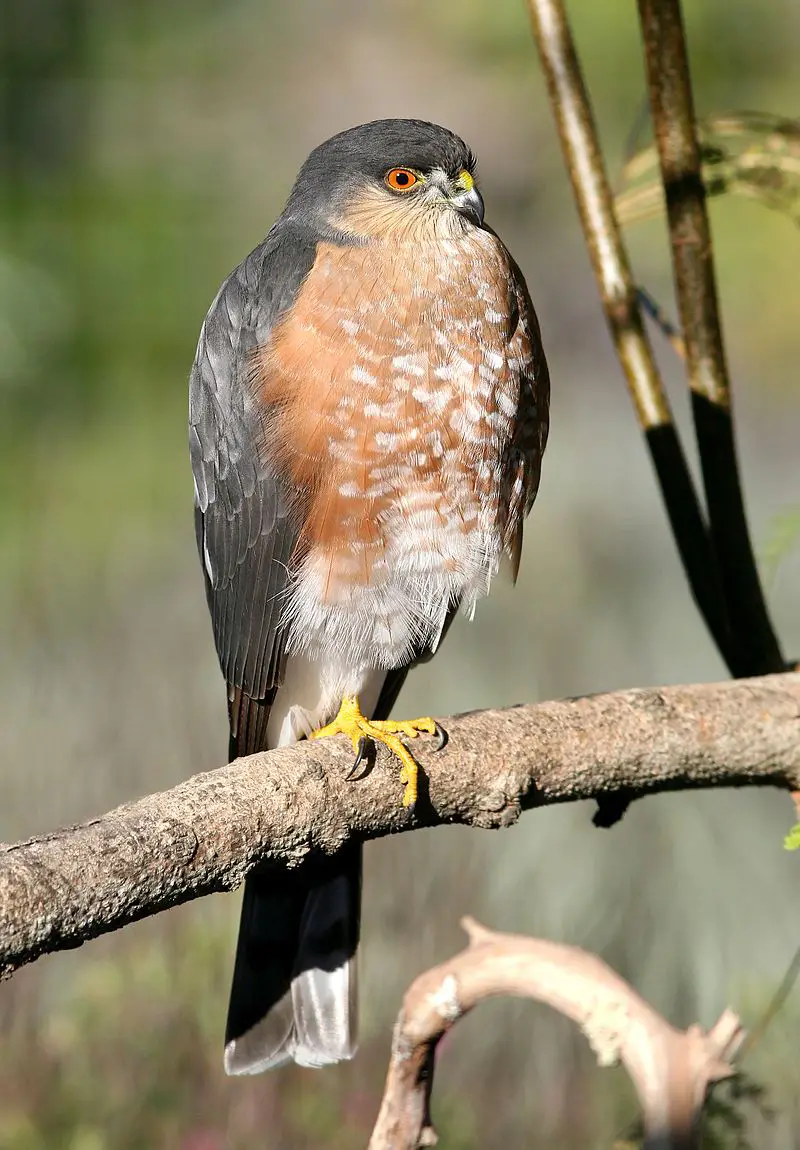
The Sharp-shinned Hawk is a small hawk found throughout the United States and Canada. It is one of the smallest hawks in North America, but larger than some Neotropical species such as the tiny hawk.
Taxonomy of this bird remains uncertain; with some authorities suggesting that southern taxa may represent three distinct species: white-breasted hawk (A. chionogaster), plain-breasted hawk (A. ventralis) and rufous morph sharp-shinnedhawk(A. rufiventris).
These birds feed primarily on small birds like finches, sparrows, woodpeckers and warblers while hunting from perches or by flying through dense vegetation to surprise unsuspecting prey items.
They are agile flyers that rely heavily on surprise to capture their food items quickly before they can fly away.Scientific classification:
| Kingdom | Animalia |
| Phylum | Chordata |
| Class | Aves |
| Order | Accipitriformes |
| Family | Accipitridae |
| Genus | Accipiter |
| Species | A. striatus |
Also Featured In: Utah Birds, Most Common Lake Birds
42. Rough-Legged Buzzard
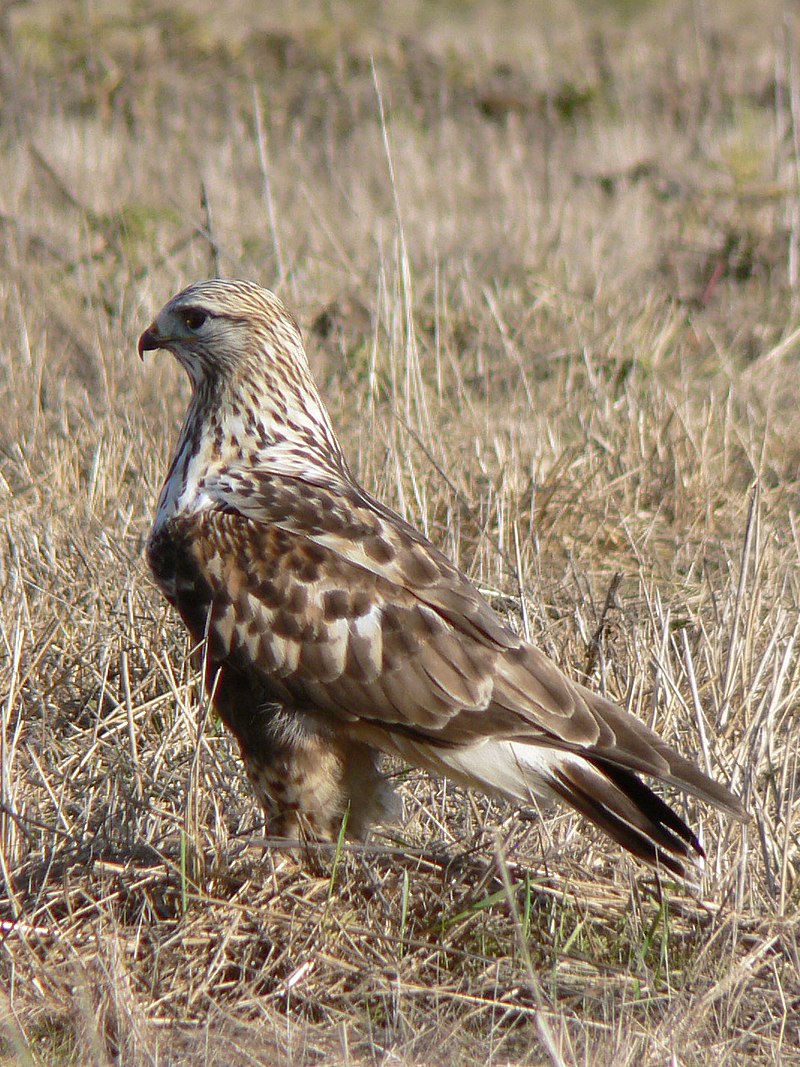
The Rough-legged Buzzard, also known as the Rough-legged Hawk, is a medium to large bird of prey that inhabits Arctic and Subarctic regions in North America, Europe and Russia.
It migrates south during winter. These majestic birds build their nests on cliffs or other rocky ledges making them difficult to spot from afar.
Their plumage can be either dark brown or light with barred underparts and a white head – depending on seasonality.
They have long wings which helps them cover incredible distances while migrating but they are by no means fast flyers – preferring instead soaring flight patterns where possible.
The primary diet for these raptors consists of small rodents such as voles and lemmings however they will take larger prey if needed (such as grouse).Scientific classification:
| Kingdom | Animalia |
| Phylum | Chordata |
| Class | Aves |
| Order | Accipitriformes |
| Family | Accipitridae |
| Genus | Buteo |
| Species | B. lagopus |
Also Featured In: birds of Massachusetts, Most Common Romanian Birds
43. Palm Warbler
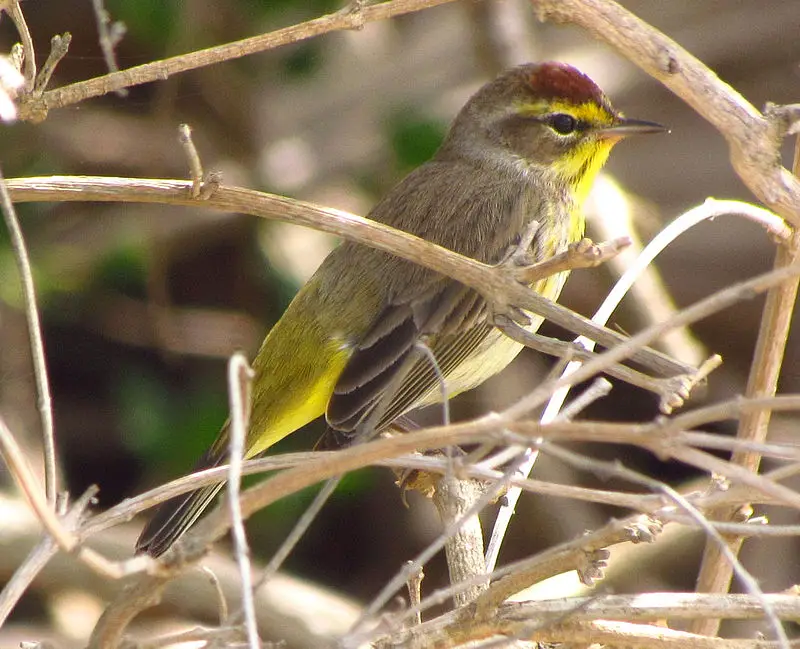
The palm warbler is a small songbird found in the New World, belonging to the warbler family.
It has two distinct subspecies that differ mainly in their plumage – eastern palm warblers have yellower underparts and bolder rufous streaks on their breast and flanks than western ones.
These birds are light olive above with whitish bellies and yellow throats.
They also have distinctive white-tipped tail feathers which they often flick while foraging or singing during breeding season, when males establish territories through song duels.
The diet of these birds consists mostly of insects such as beetles, moths, ants and caterpillars collected from trees or ground vegetation like grasses or sedges.
Palm Warblers migrate long distances between its wintering grounds near Central America to northeastern North American states where it breeds each summer before returning south again come fall.Scientific classification:
| Kingdom | Animalia |
| Phylum | Chordata |
| Class | Aves |
| Order | Passeriformes |
| Family | Parulidae |
| Genus | Setophaga |
| Species | S. palmarum |
Also Featured In: birds of Rhode Island, Birds in Iowa Spring
44. Northern Flicker

The Northern flicker is a woodpecker species found in North America, Central America, Cuba, and the Cayman Islands. This medium-sized bird is known for its unique migration behavior.
Over 100 common names are used to refer to the Northern flicker, one of them being “yellowhammer”. It is a beautiful bird with distinctive markings and a colorful plumage.
The Northern flicker is an important species in its ecosystem and plays a key role in maintaining a healthy balance in the environment.
Despite being a woodpecker, the Northern flicker has a diverse diet that includes insects, fruits, and seeds.
It is fascinating to observe this bird as it pecks at trees in search of food, communicates with its unique vocalizations and performs its incredible aerial displays.
The Northern flicker is truly a remarkable bird species that is worthy of our admiration and protection.Scientific classification:
| Kingdom | Animalia |
| Phylum | Chordata |
| Class | Aves |
| Order | Piciformes |
| Family | Picidae |
| Genus | Colaptes |
| Species | C. auratus |
Also Featured In: Birds That Live in Colorado, Birds Live in Arkansas
45. Cedar Waxwing
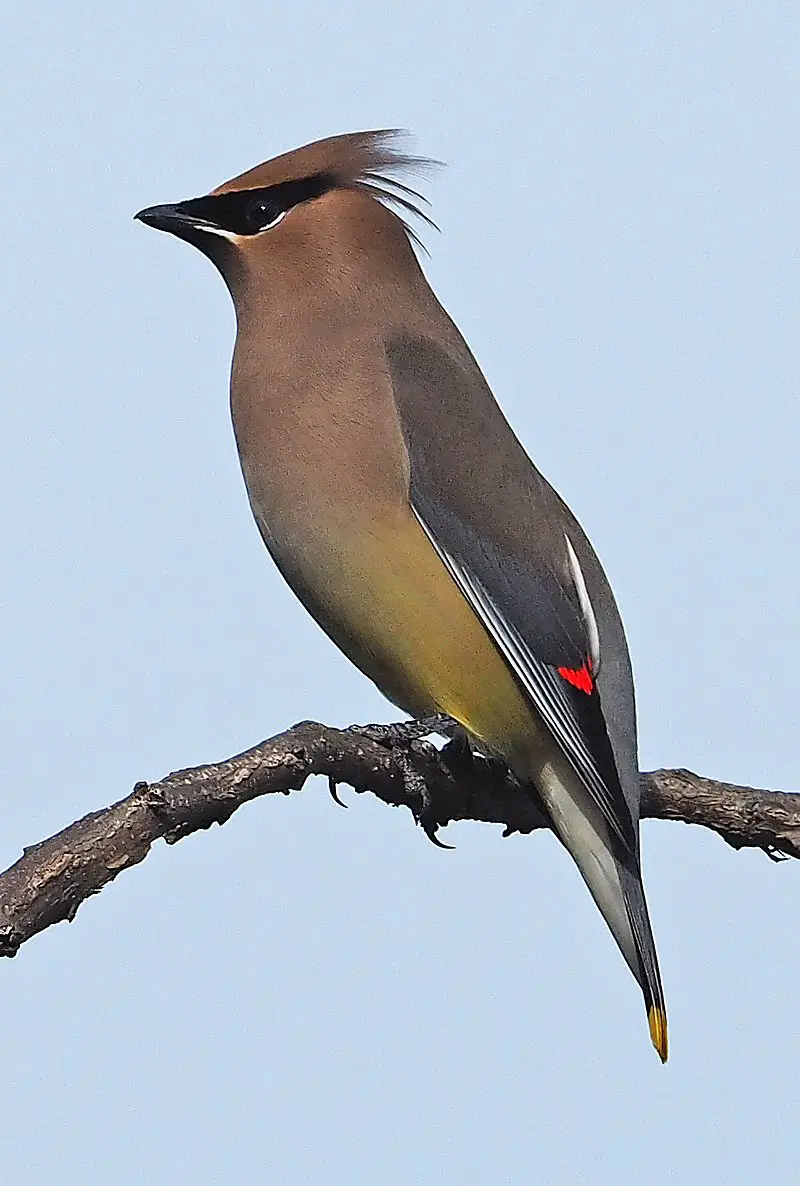
The Cedar waxwing, also known as Bombycilla cedrorum, is a medium-sized bird found in North and Central America.
They have a mixture of brown, gray and yellow feathers on their body, and their wings have wax-like tips.
These birds prefer open wooded areas in Southern Canada for breeding, and during winter, they migrate to the Southern part of the United States, Central America, and the far.
The Cedar waxwing is a member of the waxwing family of birds or Bombycillidae family.
They are known for their distinctive crest on their head and a black mask-like area around their eyes.
These birds are social creatures and can often be seen in large flocks, sometimes even intermixing with other bird species.
Their diet consists mainly of fruit and insects, and they are important dispersers of fruit seeds.
The Cedar waxwing bird is a beautiful and fascinating creature to observe in the wild.Scientific classification:
| Kingdom | Animalia |
| Phylum | Chordata |
| Class | Aves |
| Order | Passeriformes |
| Family | Bombycillidae |
| Genus | Bombycilla |
| Species | B. cedrorum |
Also Featured In: Central Texas Birds, Summer Birds that Live around Us
46. Red-Shouldered Hawk
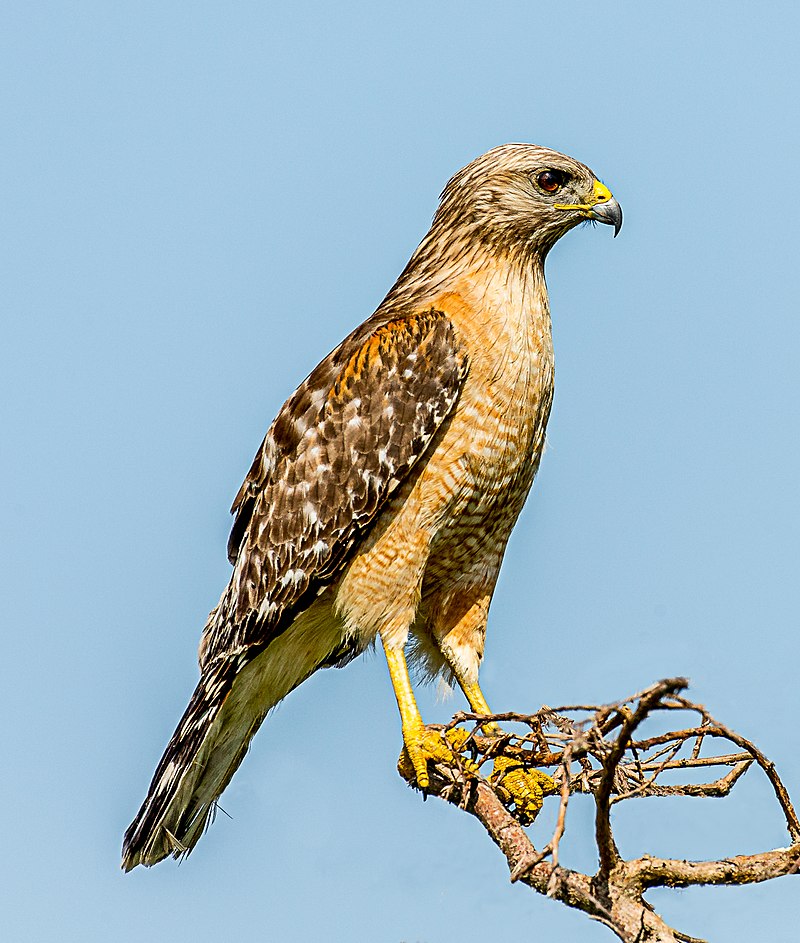
The red-shouldered hawk, also known as Buteo lineatus, is a medium-sized bird of prey found in eastern North America and along the coast of California and northern to northeastern-central Mexico.
While many of these hawks are permanent residents within their range, northern populations do migrate, with most traveling to central Mexico.
The species faces numerous threats to its survival, with deforestation being a primary issue.
Despite the many challenges they face, these birds are an important part of their ecosystems, primarily feeding on rodents, small mammals, and amphibians.
In addition to their hunting capabilities, these hawks are known for their striking appearance, featuring reddish brown shoulder feathers and bold black and white striped wings.
Overall, the red-shouldered hawk is a fascinating and important bird that plays a vital role in its surroundings.Scientific classification:
| Kingdom | Animalia |
| Phylum | Chordata |
| Class | Aves |
| Order | Accipitriformes |
| Family | Accipitridae |
| Genus | Buteo |
| Species | B. lineatus |
Also Featured In: Birds Live Near San Diego, Birds Commonly Found in Northern California
47. Northern Harrier
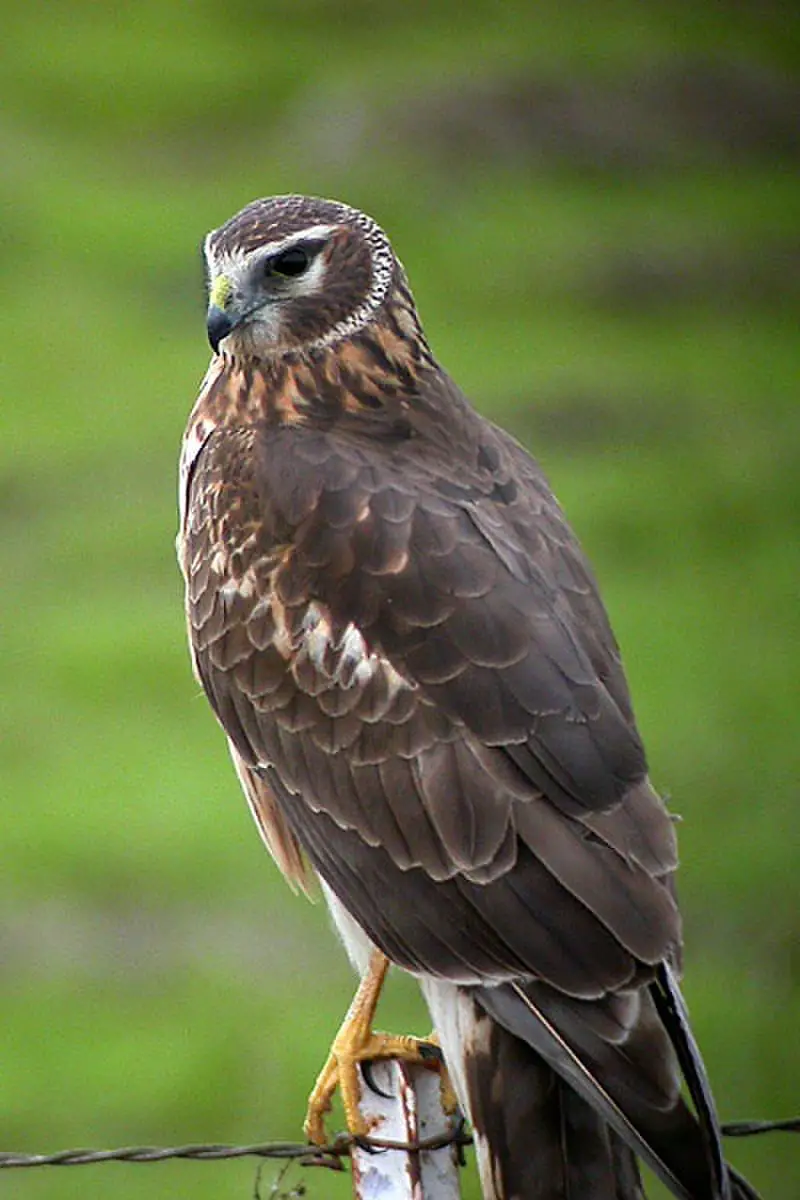
The Northern harrier, also known as the marsh hawk or ring-tailed hawk, is a bird of prey that can be found breeding in the northern parts of the northern hemisphere in Canada and the northernmost USA.
During winter, they migrate to more southerly areas, with breeding birds moving to the southernmost USA, Mexico, and Central America.
This hawk has a distinctive white rump patch that is visible during flight, making it easy to spot.
It is known for its unique hunting behavior, as it searches for prey by flying low over fields and marshes, using its incredible hearing to detect prey beneath the surface.
The Northern harrier feeds on small mammals, birds, and even insects.
They are important both ecologically and culturally and are a common sight for bird watchers in their respective habitats.Scientific classification:
| Kingdom | Animalia |
| Phylum | Chordata |
| Class | Aves |
| Order | Accipitriformes |
| Family | Accipitridae |
| Genus | Circus |
| Species | C. hudsonius |
Also Featured In: Birds that can be Seen in Outer Banks, Winter Birds of Ohio